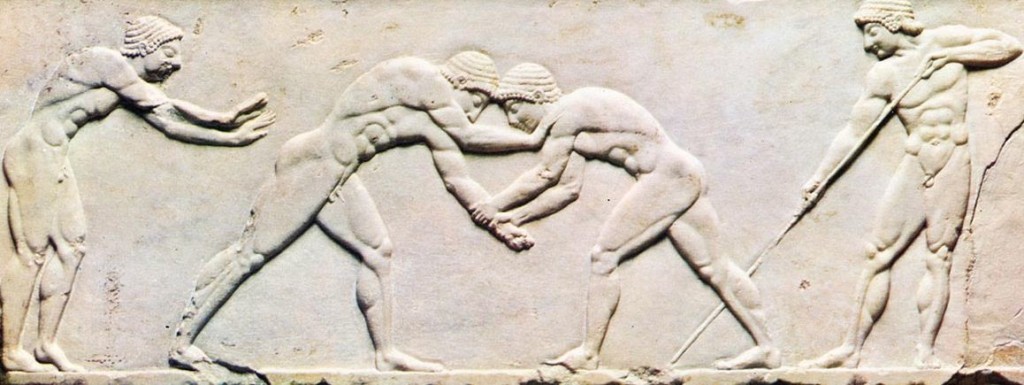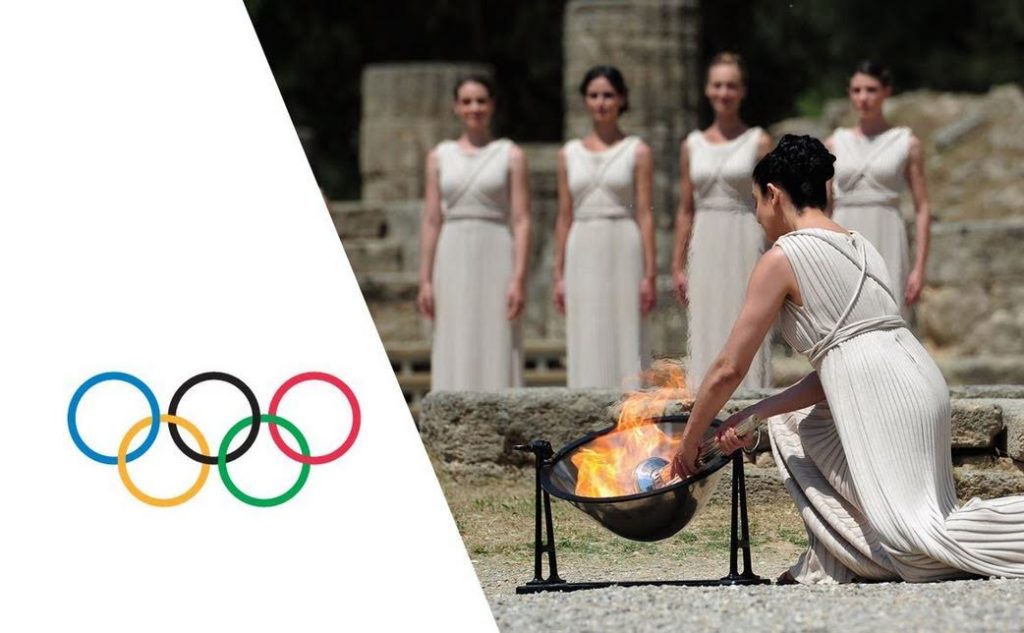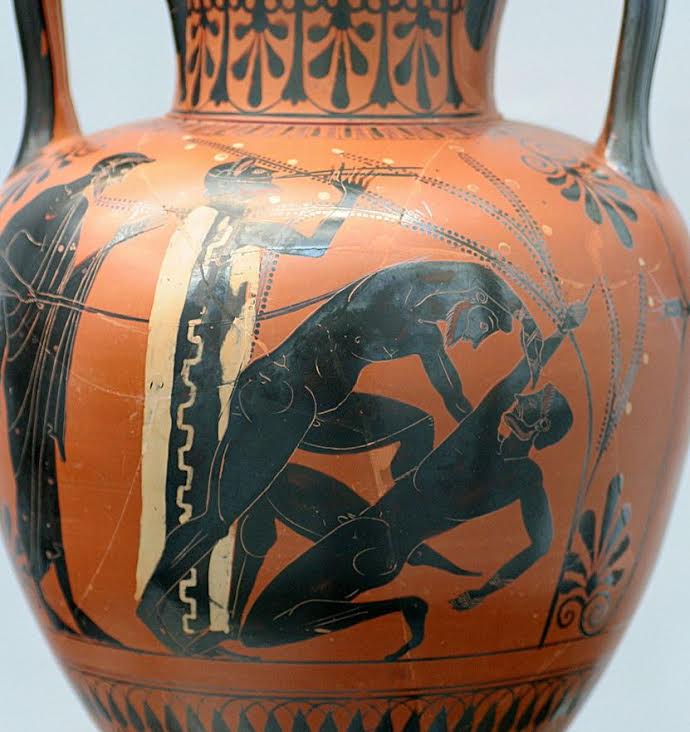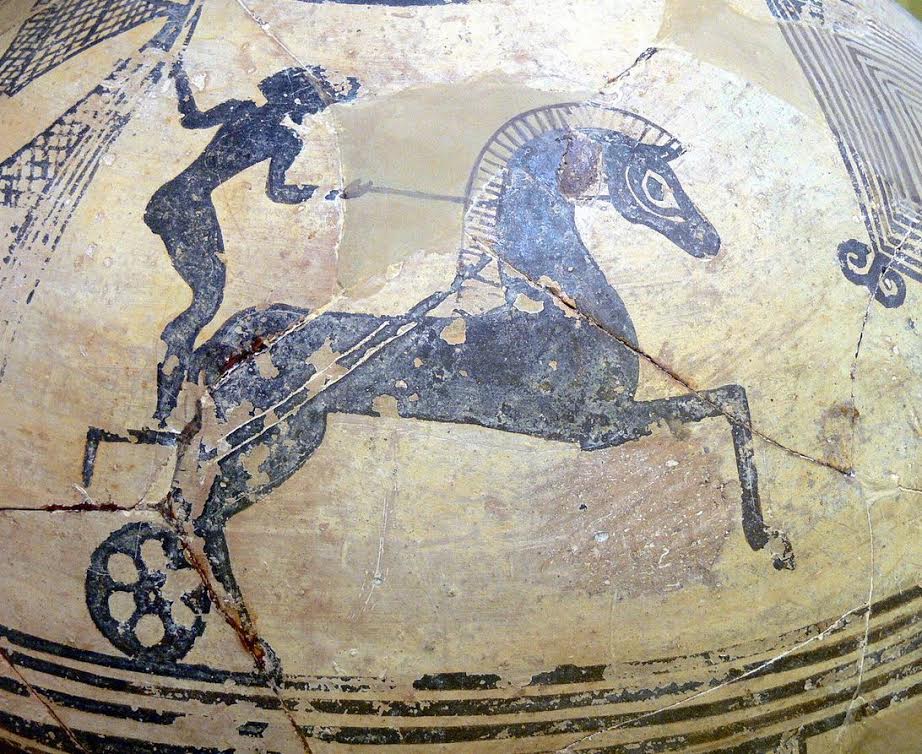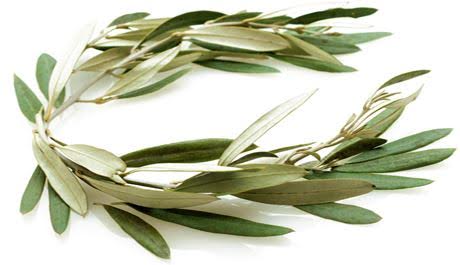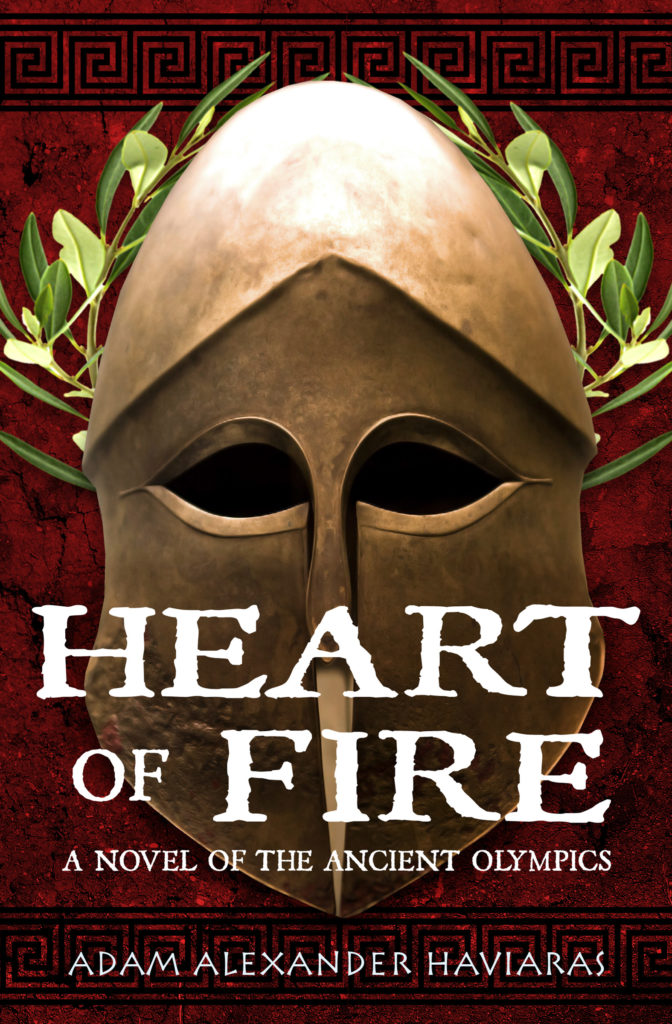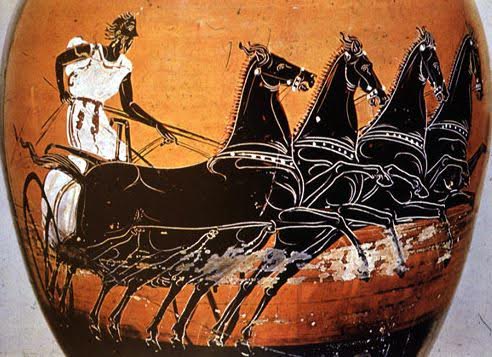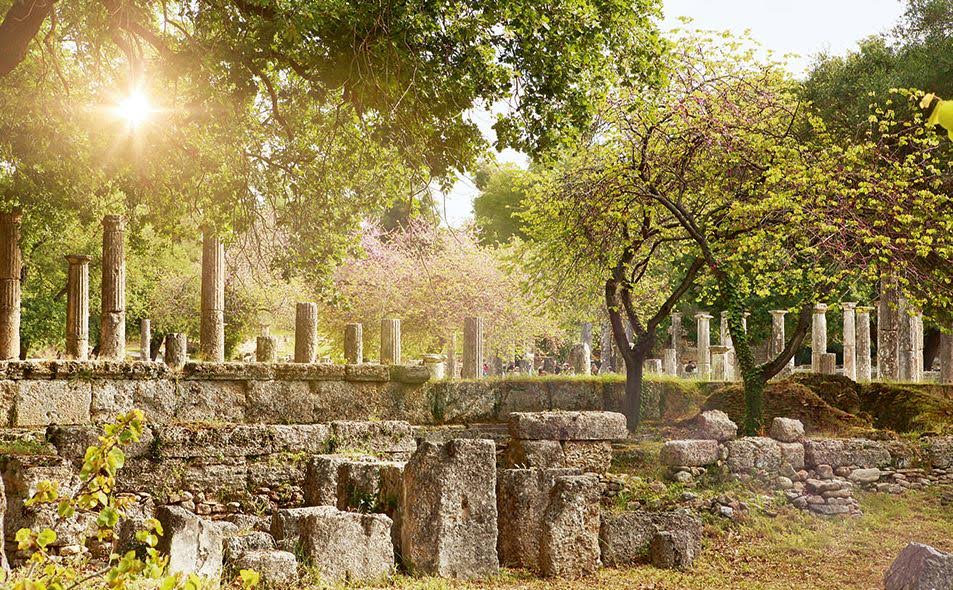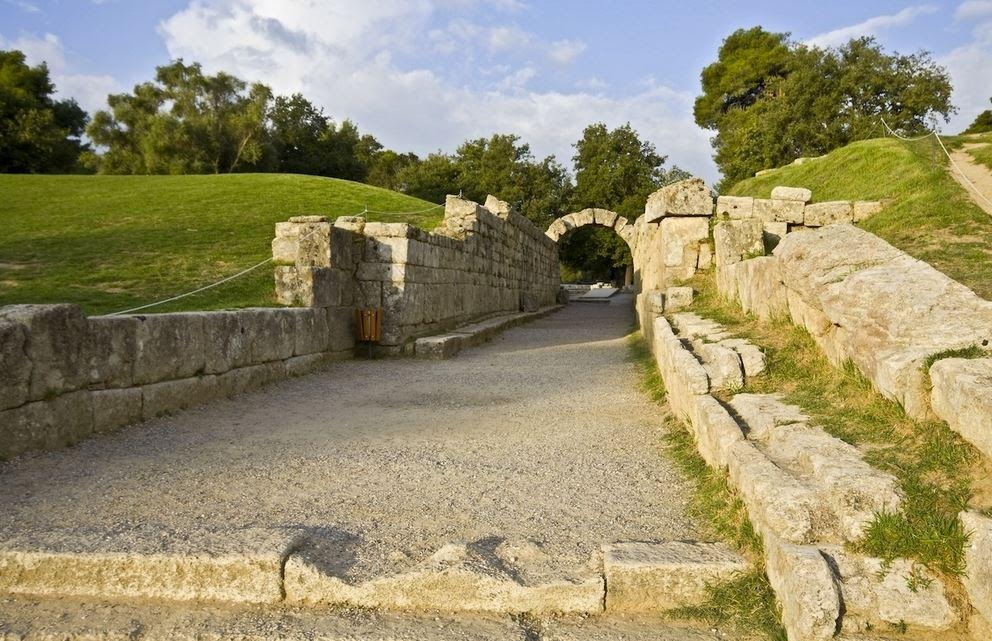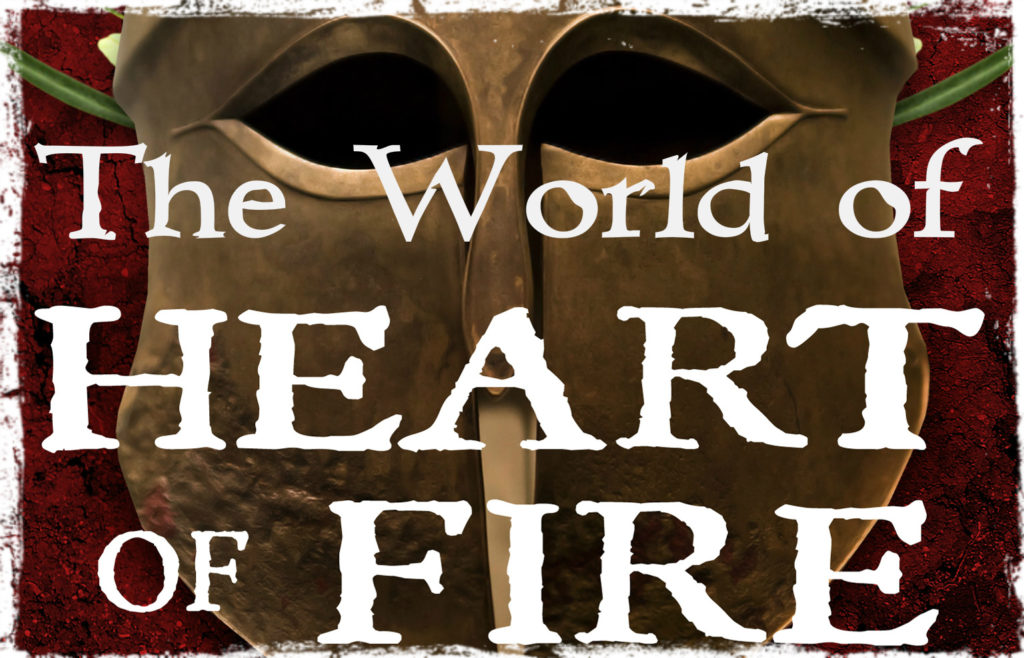
Part I
Ancient Origins – The Mythological Beginnings of the Olympic Games
Greetings readers and history-lovers!
I’m pleased to welcome you to the very first post in this blog series about the ancient Olympics and Eagles and Dragons Publishing’s exciting historical fantasy novel, Heart of Fire – A Novel of the Ancient Olympics.
In this ten-part blog series, we will be looking at all aspects of the Olympic Games from their foundation and religious ceremonies, to ancient athletics, individual sports, and the actual site of ancient Olympia as it relates to the Olympiad of 396 B.C. when Heart of Fire takes place.
In this first post, we are looking at the mythological beginnings of the Olympic Games as given in three traditions.
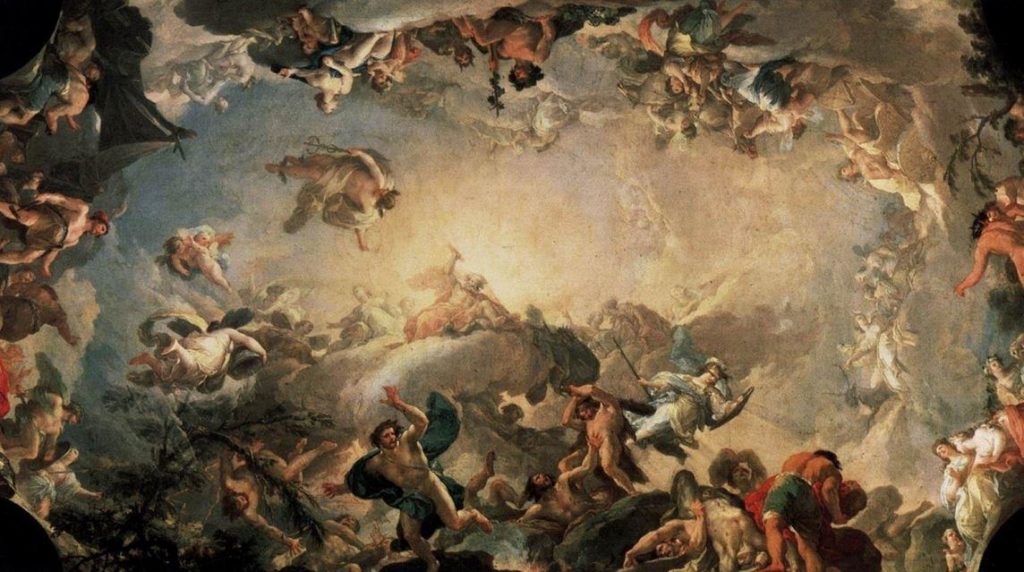
Battle between the Gods and the Titans
There are three myths related to the foundation of the Olympic Games, and the first begins with the war between the Gods and the Titans.
Ancient Olympia is dominated by an ancient hill known as the Hill of Kronos. Now, Kronos, a Titan, as we know, was the father of Zeus who, along with his siblings, waged war on Kronos and the Titans.
One of the legends associated with Olympia is that it was where Zeus wrestled with, and defeated, his titanic father. Some believe the games were established to commemorate that victory, and that the site at the base of the Hill of Kronos was where Zeus himself wrestled and defeated Kronos.
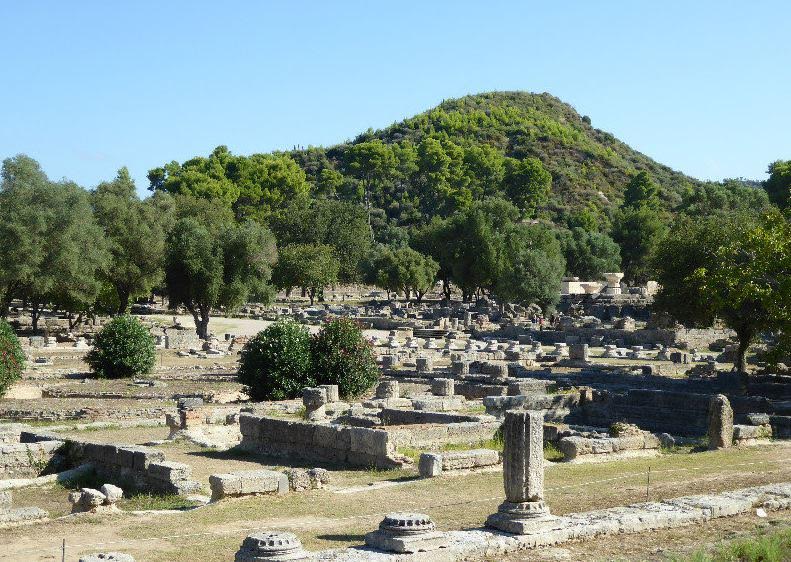
Hill of Kronos overlooking sanctuary of Olympia
Another tradition around the Olympic Games is that they were founded by Herakles in thanks to his father, Zeus, for granting him victory in war.
The great epinikion poet, Pindar, speaks of this in his Olympian Ode #10:
With the help of a god, one man can sharpen another who is born for excellence, and encourage him to tremendous achievement. Without toil only a few have attained joy, a light of life above all labors. The laws of Zeus urge me to sing of that extraordinary contest-place which Heracles founded by the ancient tomb of Pelops with its six altars, after he killed Cteatus, the flawless son of Poseidon and Eurytus too, with a will to exact from the unwilling Augeas, strong and violent, the wages for his menial labor…
…But the brave son of Zeus gathered the entire army and all the spoils together in Pisa and measured out a sacred precinct for his supreme father. He enclosed the Altis all around and marked it off in the open, and he made the encircling area a resting-place for feasting, honoring the stream of the Alpheus along with the twelve ruling gods. And he called it the Hill of Cronus; it had been nameless before, while Oenomaus was king, and it was covered with wet snow. But in this rite of first birth the Fates stood close by, and the one who alone puts genuine truth to the test, Time. Time moved forward and told the clear and precise story, how Heracles divided the gifts of war and sacrificed the finest of them, and how he established the four years’ festival with the first Olympic Games and its victories.
We will hear more about the Theban poet, Pindar, later throughout this blog series. For now, this small part of the ode mentions several things we should note. There is reference to Pelops whose tumulus was located in the middle of the Olympic sanctuary and whose story is big part of Heart of Fire.
Pindar also references one of Herakles’ labours which was to clean out the stables of King Augeas. More importantly, Pindar paints us a picture of the Olympic sanctuary and the Altis, which was marked out by Herakles as a place for rest and feasting at the base of the Hill of Kronos, and where every four years the Olympic festival was held.
At the first Olympics begun by Herakles, it is said that the gods themselves competed, with Apollo defeating Hermes in a foot race, and also defeating Ares, the God of War, in boxing.

The God Hermes running
But there is another tradition about Herakles…a different Herakles.
There were two Herakles?
Apparently so. The second was not the son of Zeus and Alcmene. He was known as Daktylos Herakles and it seems that the tradition around this second Herakles could be even older.
In the age of Kronos, when Zeus was a baby, Kronos was devouring his children (that’s a whole other story!). To keep the baby Zeus safe, his mother Rhea gave her son into the care of five Daktyloi, daimones whose duty it was to protect Zeus in a cave on Mt. Ida in Crete. To drown out the cries of the baby, the danced wildly and clashed their spears and shields together so that Kronos would not find Zeus.
Supposely, Daktylos Herakles was the leader of the five Daktyloi, who established the Olympic Games in the age of Kronos (Cronus). One of the oldest Olympic events, as we shall see in a later post, was the hoplite race in armour, and this aligns with the use of spears and shields by the five Daktyloi who were often pictured as armoured youths.
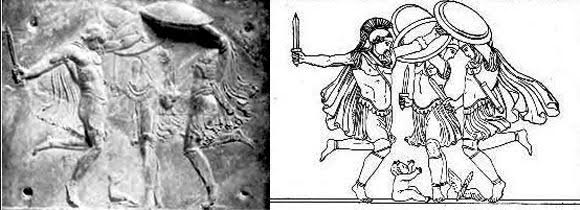
Baby Zeus and Idaean Daktyloi dancing and making noise to protect the infant Zeus
Pausanias, in his Description of Greece, touches on the Daktyloi here:
As for the Olympic Games, the most learned antiquarians of Elis say that Kronos was the first king of heaven, and that in his honour a temple was built in Olympia by the man of that age, who were named the Golden Race. When Zeus was born, Rhea entrusted the guardianship of her son to the Daktyloi of Ida, who are the same as those called Kouretes (Curetes). They came from Kretan (Cretan) Ida–Herakles (Heracles), Paionaios (Paeonaeus), Epimedes, Iasios and Idas. Herakles being the eldest, matched his brothers, as a game, in a running-race, and crowned the winner with a branch of wild olive, of which they had such a copious supply that they slept on heaps of its leaves while still green. It is said to have been introduced into Greece by Herakles from the land of the Hyperboreans, men living beyond the home of Boreas . . . Herakles of Ida, therefore, has the reputation of being the first to have held, on the occasion I mentioned, the games, and to have called them Oympiakos (the Olympics). So he established the custom of holding them every fifth year, because he and his brothers were five in number.
Now some say that Zeus wrestled here with Kronos himself for the throne, while others say that he held the games in honour of his victory over Kronos. The record of victors include Apollon, who outran Hermes and beat Ares at boxing . . .
(Pausanias, Description of Greece 5. 7. 6 – 10)
Over time, the association of Daktylos Herakles with the Games became merged with the more famous Herakles, the son of Zeus and Alcmene, whose Twelve Labours were illustrated on the frieze of the Temple of Zeus at Olympia.
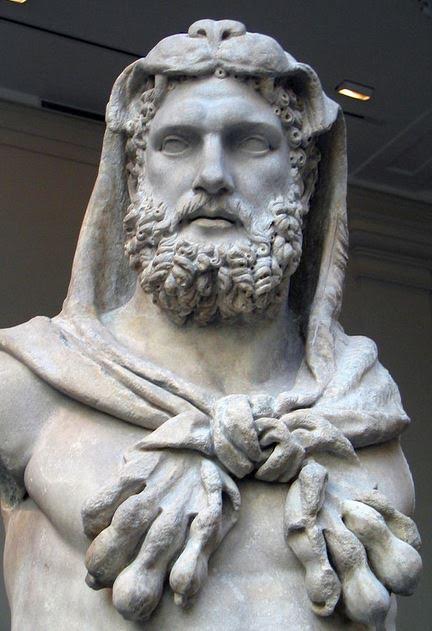
Herakles
So much for Daktylos Herakles.
There is a final myth associated with the foundation of the Olympic Games, and that is the legendary chariot race between Oinomaus, son of Ares, king of Pisa and father of Hippodameia, and the hero, Pelops, after whom the Peloponnese is named.
King Oinomaus was supposedly a cruel ‘wine-loving’ man and father who continuously slew all the suitors for his daughter Hippodameia’s hand in a chariot race from Olympia to Argos.
When Pelops, a prince from Lydia arrived to take up the challenge with the aid of some divine horses given him by Poseidon, Oinomaus’ reign of terror came to an end, and Pelops and Hippodameia were married.

Pelops and Hippodameia
Now I have really simplified the story here because we will look at it more closely in a later post. However, this particular foundation myth points to the Games as an event to commemorate Pelops’ victory.
In tandem with the Olympic Games, said to be established by Pelops in this instance, Hippodameia was said to have established the Games of Hera, the Heraia, in thanks to the goddess for granting the victory as well. You can read more about the Heraia HERE.
The chariot race was the marquee event at the Olympic Games, and central to the story of Heart of Fire, as is the tale of Pelops and Hippodameia.
There was much testament to this particular foundation myth around the Altis of Olympia as well. One of the pediments from the temple of Zeus shows Oinomaus and Pelops with their chariots, on either side of Zeus, getting ready to race.

East pediment of the temple of Zeus at Olympia showing Zeus between Oinomaus and Pelops, just before their race
Also, in the hippodrome, the chariot racing track of Olympia, a statue of Hippodameia overlooked the track, one of the turns called the Taraxippos, was said to be haunted by the angry ghost of Oinomaus, and one of the posts in the turns was said to be made from a beam from Oinomaus’ burnt house.
In the middle of the Altis there was also the Pelopion, the burial mound of Pelops which became a shrine to the hero who would become the father of Atreus, and grandfather of Agamemnon and Menelaus, those well-known kings of Mycenae and Sparta.
I know this is a lot of information to take in, but it just goes to show the complexity and richness of the traditions attached to Olympia and the mythological foundation of the Olympic Games.
As we explore this ancient event, we will be travelling through a world where myth, religion, history and sport are all melded together to give us one of the greatest legacies passed down to us from Ancient Greece.
Thank you for reading and starting your journey into The World of Heart of Fire.
Part II
776 B.C. – The Historical Beginnings of the Olympic Games
In the last post we looked at the mythological origins of the Olympic Games.
In part two, we are going to take a brief look at the Olympic Games as history remembers them, though, that too is hazy undertaking.
Most historians agree that the first recorded Olympic Games took place in 776 B.C. and ran for almost twelve centuries until they were banished as a pagan practice by the Christian, Roman emperor, Theodosius I in c. A.D. 394.
When the games began in the eighth century, the city-states of Greece were on the rise, and so it was inevitable that politics would enter into the Games early on. Olympia was actually fought over, and an example of this was the ongoing argument between Elis and Pisa, an argument in which Sparta eventually became involved.
Control of Olympia passed back and forth between Elis and Pisa, but the Eleans eventually won out. Nevertheless, the Olympic Games were a place where city-states met and declared their strength, their grievances, and their alliances.
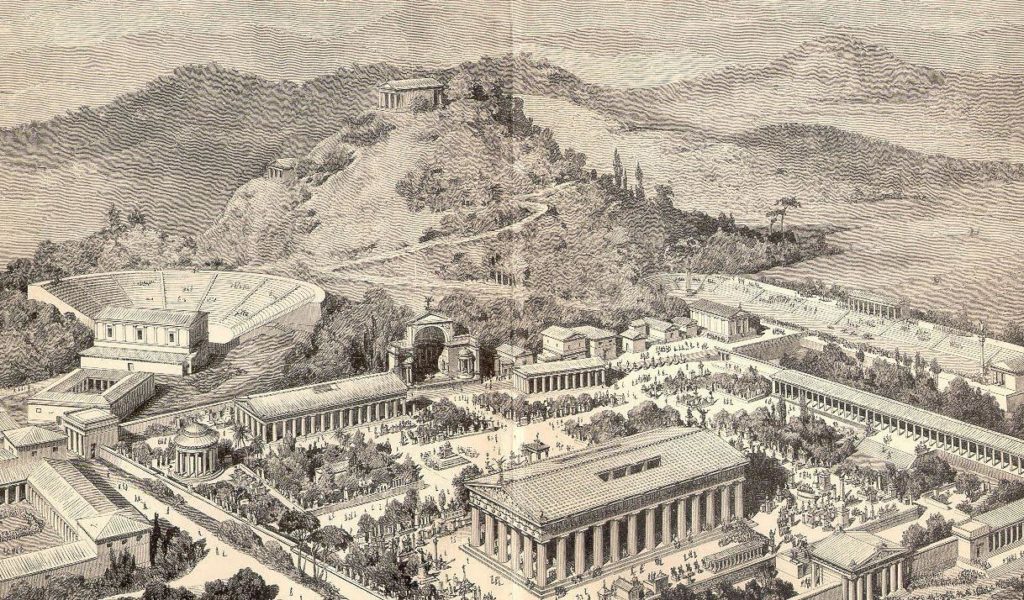
Artist impression of Ancient Olympia
Despite the occasional rancour and politicizing of the Games, the Olympiad remained a sincere religious ritual overseen by the Gods themselves and in honour of Olympian Zeus.
There were other ‘crown games’, as they were known. These included the Pythian Games in honour of Apollo at Delphi, the Nemean Games in at Nemea, and the Isthmian Games in honour of Poseidon at ancient Isthmia, near Corinth.
Many men competed in all of the crown games, but the Olympiad was the greatest and most revered of these games. A victory there made a man all but immortal.
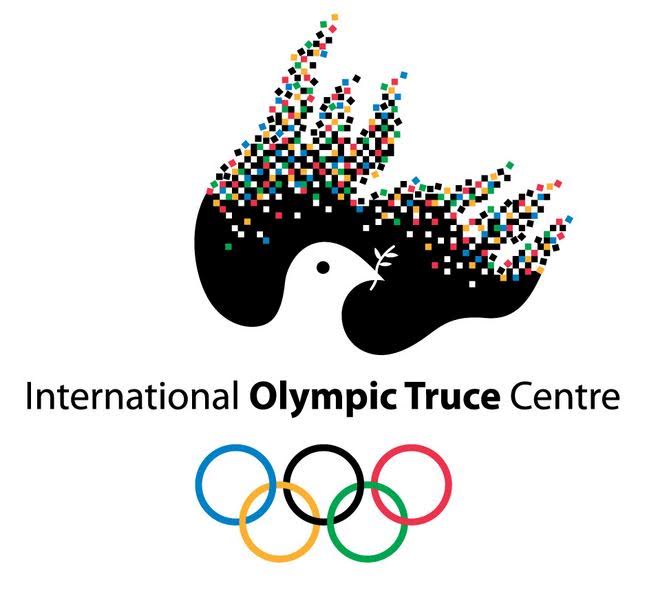
Modern IOC symbol for Olympic Truce – the tradition continues!
When the Olympic Games were declared, the entire Greek world was supposed to come to a standstill during a peace known as the Sacred Truce, or Ekecheiria, which means a ‘laying down of arms.’
To violate the peace of the Sacred or Olympic Truce, was to dishonour the Gods and risk their anger.
This would have been difficult during a time such as the Peloponnesian War when the city states were at each other’s throats and tearing their world apart. It is no surprise that Olympic competition could turn deadly, but more on that later.
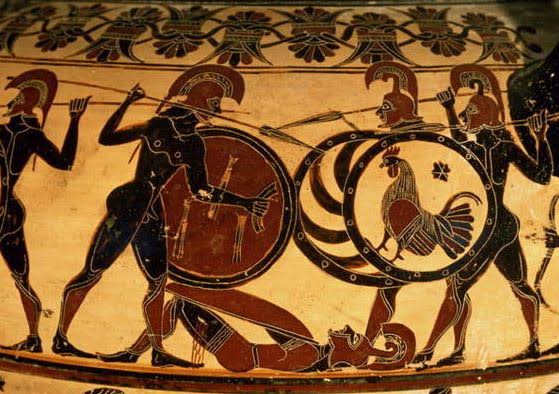
Greek hoplite battle
Only freeborn, Greek men were permitted to compete in the Olympiad, and at first, it was mainly men from the Peloponnese, as evidenced by the high number of Arkadians on the early victor lists.
Women, as mentioned in the previous post, were only permitted within the sanctuary during the Games of Hera, the Heraia, the first officially recorded one of which took place in the sixth century B.C.
The banishment of women from the Games, it is said, began around 720 B.C. when men began to compete in the nude rather than loin cloths.
Initially, the Olympic Games took place over a single day, and the only event was the stade race. This was a sprint of about 200 meters, which was the length of the stadium at Olympia, said to have been measured after the steps of Herakles himself.
So, the original Olympic event was the two-hundred meter sprint!
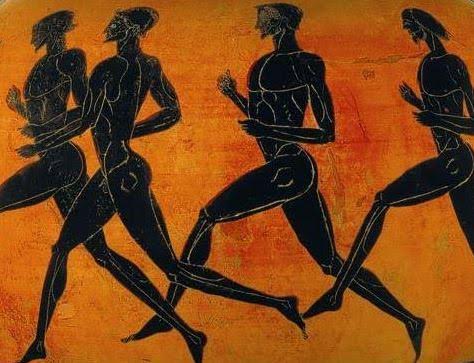
Ancient greek runners
Over time, as Greek colonies began to spread across the Mediterranean world, and the Games grew in popularity, Greeks from outside of the Peloponnese, much farther afield, began to travel to Olympia to compete. More days, and more events were added to the games until we arrive at the year in which Heart of Fire takes place – 396 B.C.
This was a brutal period in Greece’s history. All of the city states were bitter and reeling from the Peloponnesian War (c. 431-404 B.C.), and they were still having at each other, even in the midst of a supposed peace, called the Peace of Nicias.
Sparta and Athens were at the forefront of the aggressions, as were Thebes, Corinth, Argos and others. The Olympiad of 396 B.C. has certainly been an interesting and complex period to write about. We’ll explore the politics of the period more in the next post.
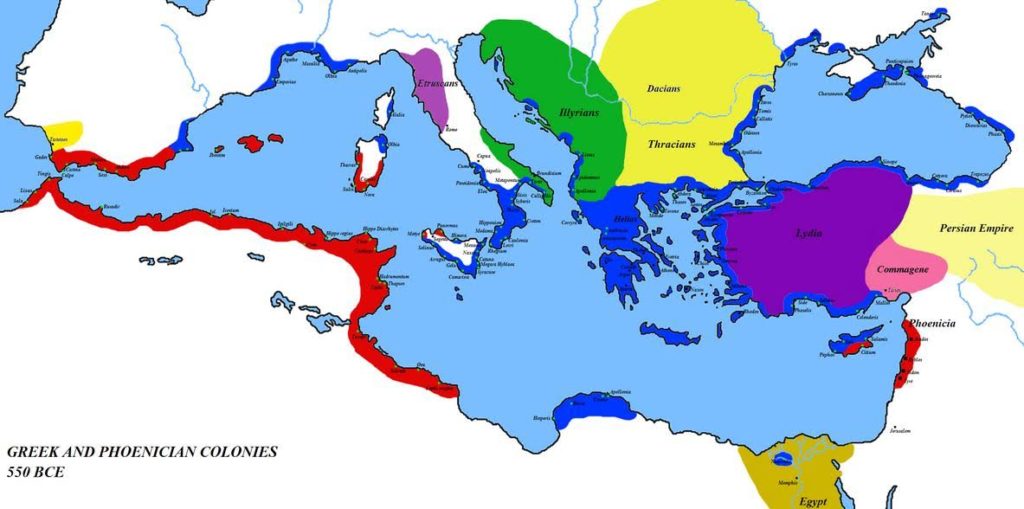
Greek Colonies of Mediterranean (in blue)
By the time of the 396 B.C. Olympiad, the Games were five days long, rather than the original one, and had many more events. Here is the most agreed-upon order of events:
Day 1 – This was the day for the equestrian events, including bareback horse races, the two-horse chariot race, the Synoris, and the marquee event, the Tethrippon, or four-horse chariot race.
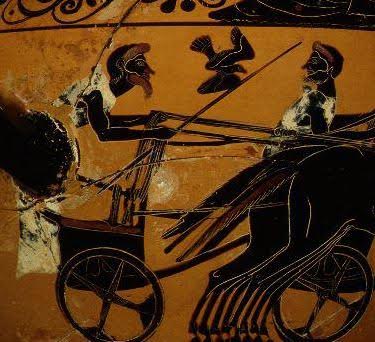
Chariot Race
Day 2 – This was the day for the Pentathlon which was an event that tested the best, all-around, warriors, It included a stade race of 200 meters, standing long jump with the use of weights called halteres, the discus, the javelin or akontismos where throws could soar over 100 meters, and lastly wrestling.
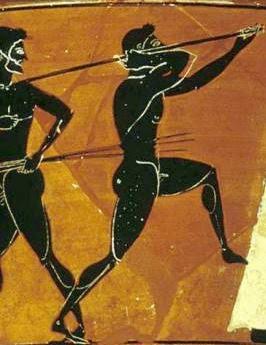
Javelin thrower
Day 3 – The third day was reserved for the foot races. By 396 B.C., these included the stade race (200 meters), the diaulos (400 meters), and the dolichos (a long distance race that could be anywhere from 2,400 to 5000 meters). About twenty runners competed at a time, having chosen lots to determine their heat. They stood on the starting line of the stadium and waited until the judge yelled “Apite!”
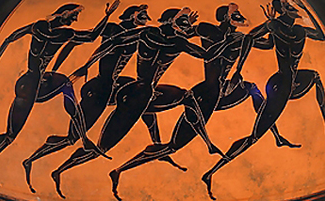
Runners
Day 4 – This was the day of the fighting events, and make no mistake, these were brutal. Men died. These included the wrestling, boxing, and the no-holds-barred Pankration.
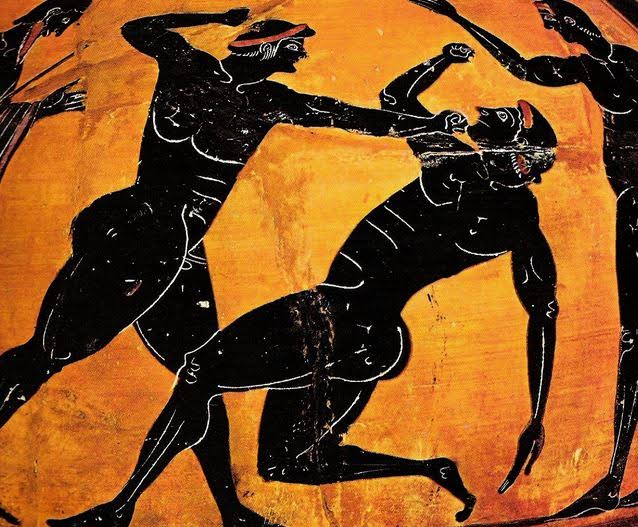
Pankration
Day 5 – The last event of the ancient Olympics is one that has faded away into the pages of history, but which has its origin, some believe, in the foundation myth of Daktylos Herakles, mentioned before, and the armoured Daktyloi who were charged with protecting the baby Zeus on Mt. Ida in Crete in the age of Kronos. This final event was a hoplite race, a sprint for men dressed in full hoplite armour and each running with one the twenty sacred shields that were stored in the Temple of Hera at Olympia. This was known as the Hoplitodromos, and in Heart of Fire, we get to experience this unique and almost forgotten Olympic event.
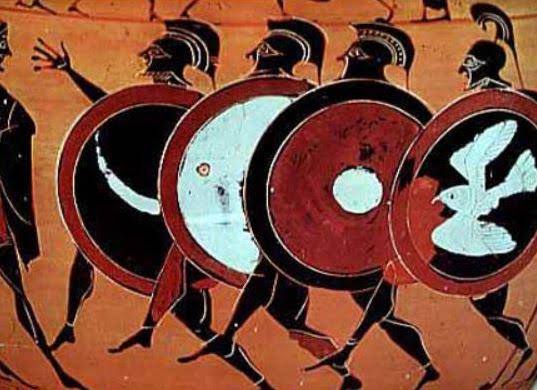
The Hoplite Race
So, there you have it! Those are the events of the ancient Olympic Games. Much has changed, though it is fantastic to think that some of the Olympic events we have today started so very long ago.
But sport was only a part of the ancient Olympics. It’s important to remember that overall, this was a major religious ritual that commanded respect from all Greeks, despite the politics of the day.
In Part III of The World of Heart of Fire, we are going to look at the importance of athletics in Ancient Greece and delve a bit more into the political atmosphere of the year 396 B.C.
Thank you for reading.
Part III
Athletics and War in Ancient Greece
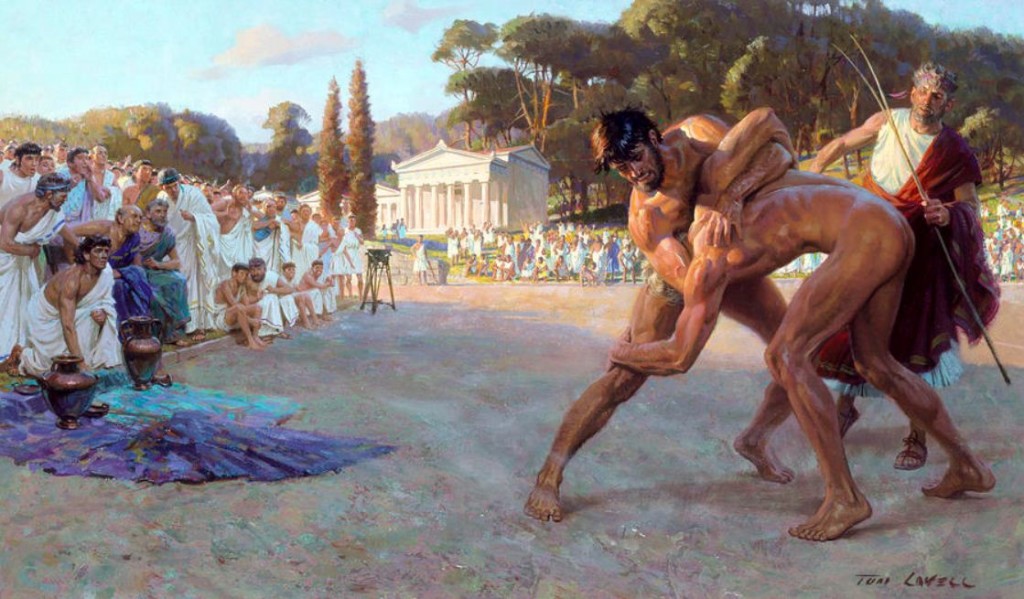
Artist re-creation of ancient wrestling
Nearly all the sports practised nowadays are competitive. You play to win, and the game has little meaning unless you do your utmost to win… At the international level sport is frankly mimic warfare… Serious sport has nothing to do with fair play. It is bound up with hatred, jealousy, boastfulness, disregard of all rules and sadistic pleasure in witnessing violence: in other words it is war minus the shooting. (from George Orwell’s The Sporting Spirit, Tribune, December 1945)
This is from an oft-quoted work by George Orwell after a particularly violent football match in 1945 between England and Russia.
With our modern sensibilities toward sportsmanship and fair play, many of us would agree with George Orwell’s sense of disgust at the violence that had permeated sport. Click here to read the full piece. That said, today, with the pervasiveness of violence in the media, including sports coverage, I think our modern sensitivities toward sport have taken a few steps backward.
However, when it comes to the ancient Olympics, the quote above rings true.
In this third part of The World of Heart of Fire, we are going to look briefly at the relationship between athletics and war in Ancient Greece, and how the political atmosphere at the time made for some brutal competition on, and off the battlefield.
If you read the full piece by Orwell, you will see that he mentions a decline in the importance of athletics from the Roman period onward.
In the Greek world, however, athletic training was central to a young man’s education, and in Sparta, to a woman’s as well.
Before we delve deeper into the relationship between athletics and war, we should take a brief look at the athletic institutions that were crucial to a young man’s education – the Gymnasium, and the Palaestra.
In Ancient Greece, one of the key markers of a civilized city was the presence of a gymnasium. Now, this is not the sort of gym where today, young kids play dodge ball, or where people go to pump some iron and then head home. There was much more to the ancient gymnasium than that.
A gymnasium was a public institution for young men over eighteen years of age, a place where they went, not only to train for the public games or sporting events, but where they also trained for life.
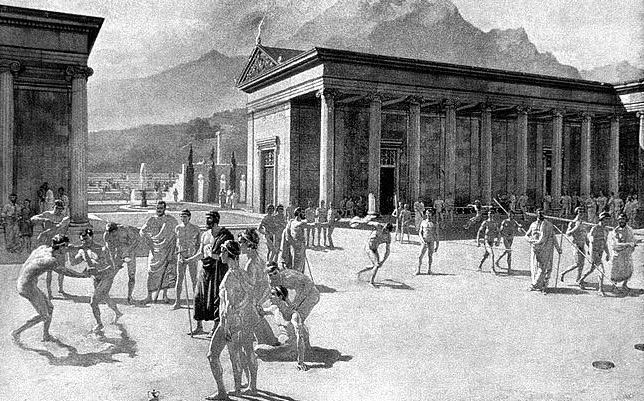
Artist impression of a gymnasium
In addition to sports training, there were also lectures on philosophy, art, music, and literature. Gymnasia were really schools for a society’s future leading citizens, especially in a democracy.
According to Pausanias, it was Theseus who first regulated gymnasia in Athens. Later, the great lawmaker, Solon, created a set of laws to govern gymnasia.
A gymnasium was a large facility that included a palaestra, baths, a stadium for competition, and porticoes where lectures were given by philosophers and discussions could be had, especially in inclement weather.
The great gymnasium of Olympia is one of the most famous, and the remains can be seen to this day.
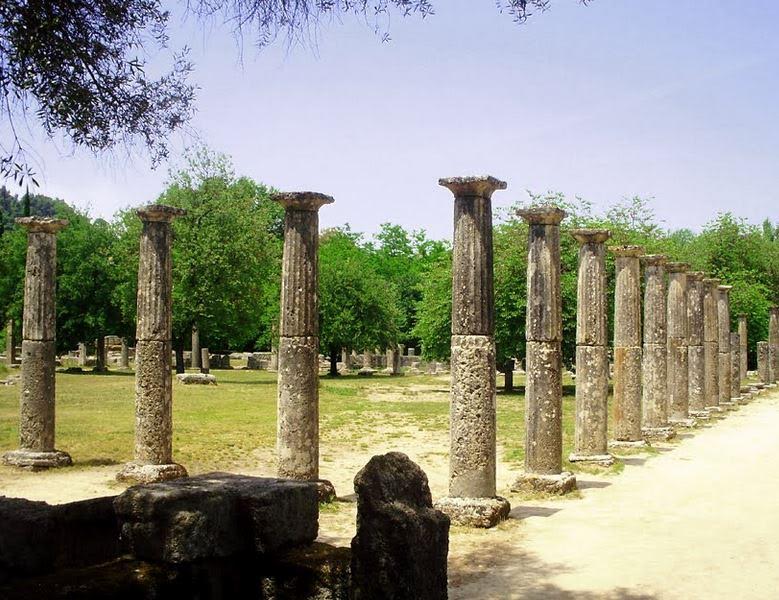
Remains of Olympia Gymnasium
At Athens, there were three famous gymnasia – The Academy (founded by Plato), the Lyceum (founded by Aristotle), and the Cynosarges (founded by Antisthenes) where the cynic school was said to have begun.
These are some pretty big names, and their involvement and founding of these institutions only speaks to the importance of gymnasia in Greek society.
The other important institution is the palaestra.
This was a wrestling school. It could also be considered a martial arts school, for it was a place where not only wrestling was taught, but also boxing and pankration.
A gymnasium always included a palaestra, but a palaestra could be a stand-alone entity, as well as privately owned.
Olympia is one of the best examples of a palaestra.
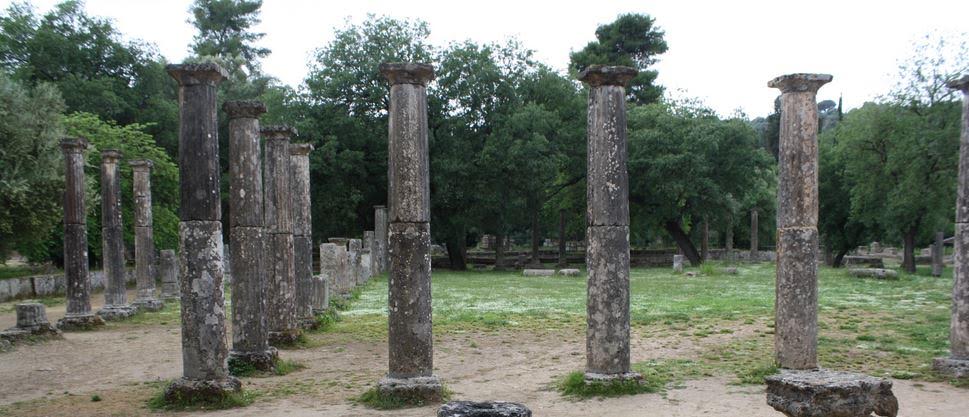
Olympia Palaestra
This was like an athletic club, a place where men could train for combat and competition, but also socialize and bathe.
A palaestra was typically a rectangular or square building with a colonnade surrounding a sandy area where fighting took place called a skamma. There were adjoining rooms off of the main courtyard that could be used for socializing, games, and bathing, as well as storage rooms where oil and dust were stored.
While lectures could take place at a palaestra, they were mainly focussed on the physical strengthening, skill, and improvement of young men.
The importance and prestige of belonging to a palaestra cannot be overstated when it comes to Ancient Greek society. So much so, that there was a term for those who were poor, those who were without a palaestra – apalaistroi.
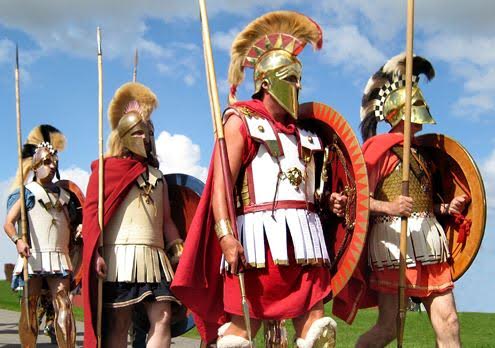
Re-enactors dressed as hoplites
It is important that we not kid ourselves here. Athletics and war were very closely related in Ancient Greece, and any man who was expected to wield a hoplon and doru in the shield wall of a phalanx was likely someone who trained at either the gymnasium or palaestra.
Sport and athletic competition was indeed ‘war without the shooting’ as Orwell so aptly put it.
In Greek society, words like arete (‘manly excellence’), andreia (‘manliness’), eumorphia (‘in good shape’), promachoi (‘fighters in the front line’), and philonikia (‘love of winning’) were deeply ingrained in a young man’s psyche, in his training to be an effective citizen for his city-state.
These are ideas that I have tried to weave into the story of Heart of Fire, for they are so very important to understanding this world that, let’s face it, despite the similarities, is so very different from our own.
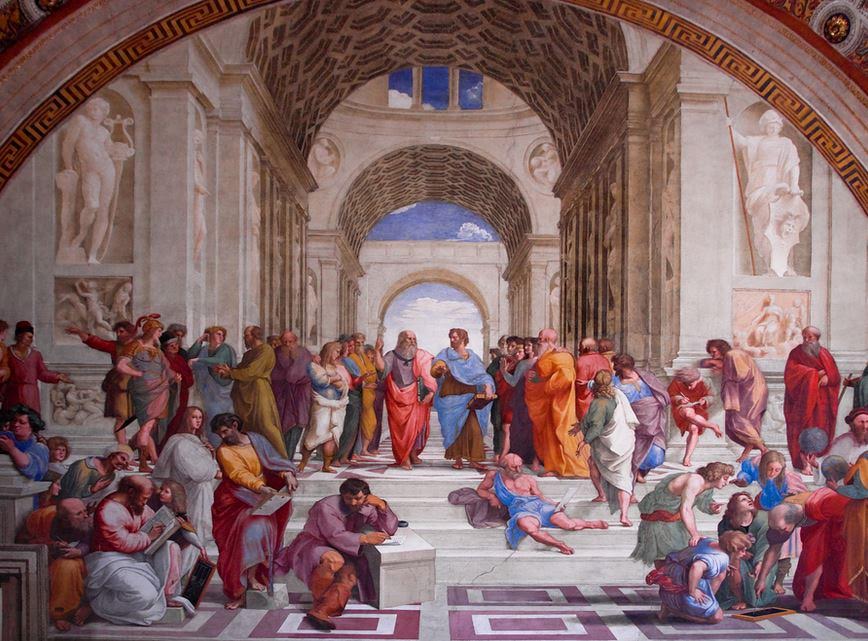
Plato’s Academy
But now we must look at the politics of the time in which Heart of Fire takes place, for at this time, when the entire Greek world was drowning in fire and blood, all of the training young Greek men would have received at the gymnasium or palaestra would be turned to combat on the fields of Ares.
To my mind, the Peloponnesian War is a supremely depressing episode in Greek history. After the glories of the Persian Wars, when the Greeks united to stand against a common foe, it is heart-breaking to see how they tossed the glory of their fathers to the winds.
Marathon, Thermopylae, Salamis, and Plataea were no more…
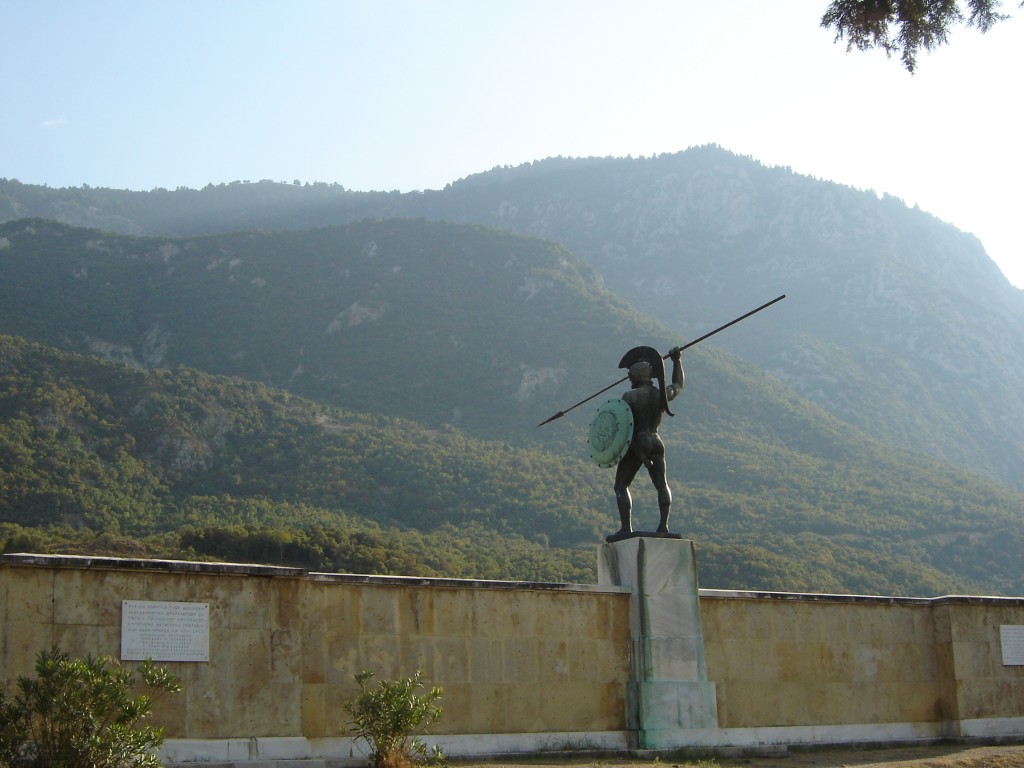
The Pass at Thermopylae
Despite the efforts of some philosophers such as Isocrates of Athens (436-338 B.C.) to persuade the city-states to unite and focus on Persia once more, the Greeks turned on each other.
The Peloponnesian War (431-404 B.C.) was mainly a conflict between the two major city-states of the day, Athens and Sparta, and their respective allies.
This war saw the ‘death’ of Athens and, some might say, Democracy. It saw Sparta ally itself with the Persians against her fellow Greeks, and it saw Greece’s Golden Age turn to dust.
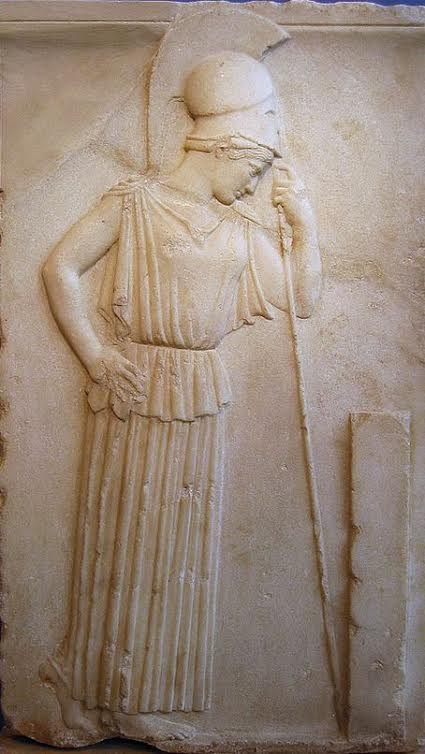
Mourning Athena
After ten years of heavy losses on both sides of the conflict, Athens and Sparta brokered a peace called the Peace of Nicias (421 B.C.), named after the Athenian general who led talks. This peace declared a peace treaty between Athens and Sparta for fifty years, with temples all over Greece being open to all again, granting autonomy to Delphi, and the return of territories and POWs.
Sadly, this peace broke down almost at once. In 418, Sparta was victorious over Athens, Argos, and other pro-democrats at Mantinea. Then, in 417 B.C., Sparta attacked Argos at Hysiae.
In 415 B.C. Athens attacked the Spartan ally of Melos and committed major atrocities there before planning their ill-fated Sicilian Expedition against the Spartan ally of Syracuse. What followed was a massive Athenian defeat with the loss of nearly a generation of Athenian youth, and the instalment of the men known as the 30 Tyrants (404-403 B.C.)
The 30 Tyrants were a pro-Spartan oligarchy installed in Athens after the latter’s defeat in the Peloponnesian War in 404 B.C. They were in power for thirteen months, a time in which the thirty instituted a reign of terror in which nearly five percent of Athens’ population was killed and their property taken.
Democracy went into exile, and the democrats in exile grew stronger and more determined the more brutal the 30 Tyrants became.
The Greek world was bitter, battered, and bruised.
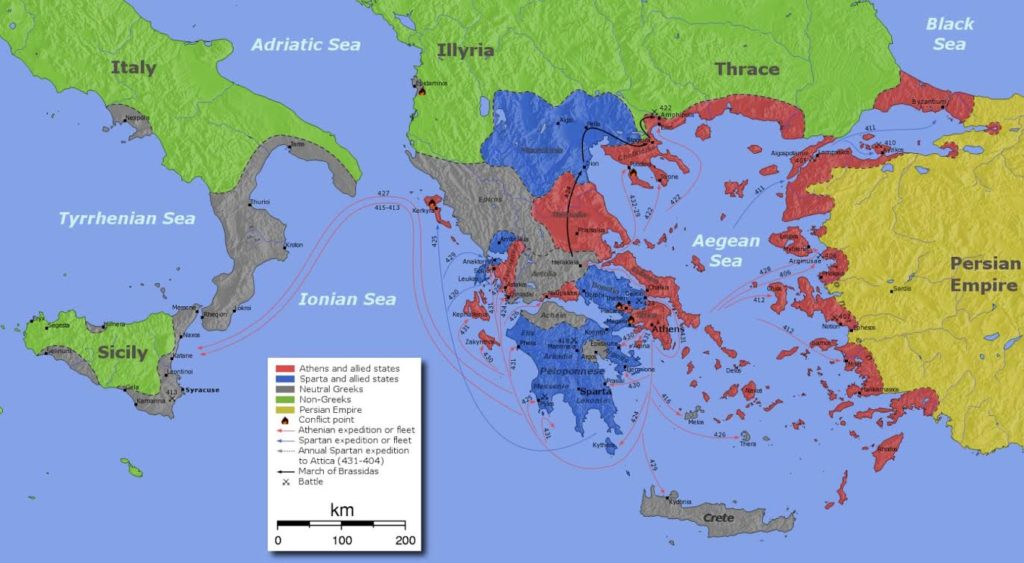
Map of movements during the Peloponnesian War
This was a time of retribution, and with the defeat of the 30 Tyrants by the pro-Democratic forces led by the Athenian general, Thrasybulos, Athens seemed to forget her ideals and former glories in some ways, threatening to kill all those who sought to destroy their Democracy.
This is the period just prior to when Heart of Fire begins, a period that saw to the public trial and death of one of Ancient Greece’s most famous and influential people – Socrates.
This is also the time when, after the battles had slowed, and warriors now found themselves idle, 10,000 Greek mercenaries joined the losing side in the Persian civil war and found themselves marching back to Greece while harried by Persian forces who wanted nothing more than to slaughter them.
This last event is recounted in the Anabasis of the exiled Athenian warrior, Xenophon. It is known as the March of the 10,000.
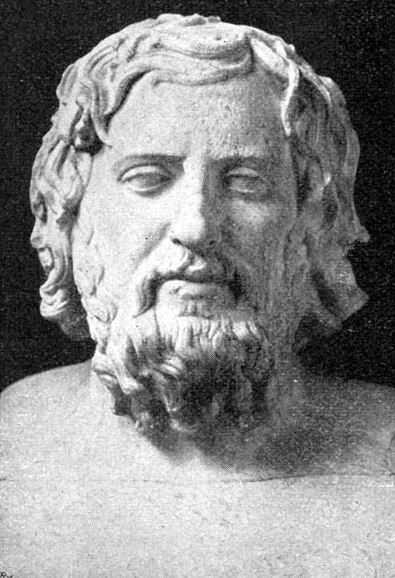
Xenophon, son of Gryllus
What did all this blood, battle and hardship have to do with athletics?
Everything.
In Ancient Greece, the lessons young men learned in the gymnasium, or on the sand of the palaestra, were implemented on the battlefield.
Athletics training really was ‘war without the shooting’, and athletic events such as sprinting, jumping, wrestling, boxing, javelin, and running in full armour, served non only to make men better citizens, but also better, more effective warriors for their city-state.
And with the state of the Greek world at the time Heart of Fire takes place in 396 B.C., there were a lot of men fresh from the battlefield who had come to compete in the Olympic Games after the Peloponnesian War.
The Sacred Truce was instituted once more, but one can imagine the tension at Olympia during those games, after all that had happened in the last forty years.
The Games of 396 B.C. were about more than proving oneself in the eyes of the gods and honouring the city-state. They were about winning at all costs.

Greek hoplites in battle
Sadly, after those Games, yet another war broke out, known as the Corinthian War (395-387 B.C.) in which Sparta and her oligarchical allies waged war on the Democratic cities of Athens, Thebes, Corinth and Argos.
The cycle of sport and war seemed to continue.
Part IV
Ancient Olympia in 396 B.C.
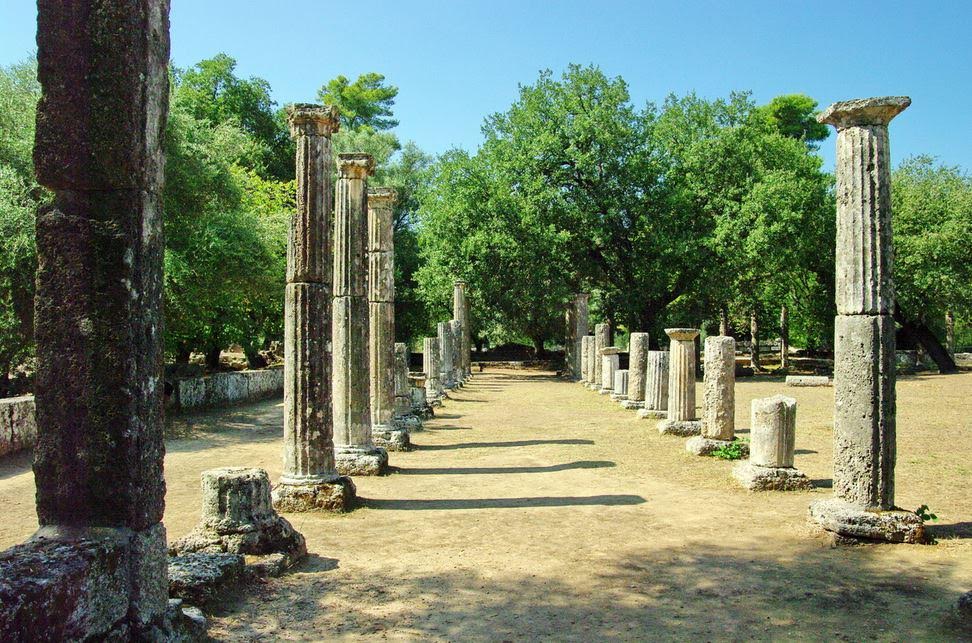
The ancient Olympics took place where the rivers Kladeos and Alpheios met, on a lush green plain flanked by ancient hills.
There has been human activity, and worship of the gods here for ages, long before the Olympic Games, but the ancient Olympiad is the reason we know this sort of paradise.
At least that is what it feels like to me when I visit the site. To me, ancient Olympia is a place of peace, a place for thought and feeling where one can still hear the roar of the crowds and the chanting of priests in worship of Zeus, Hera and others.
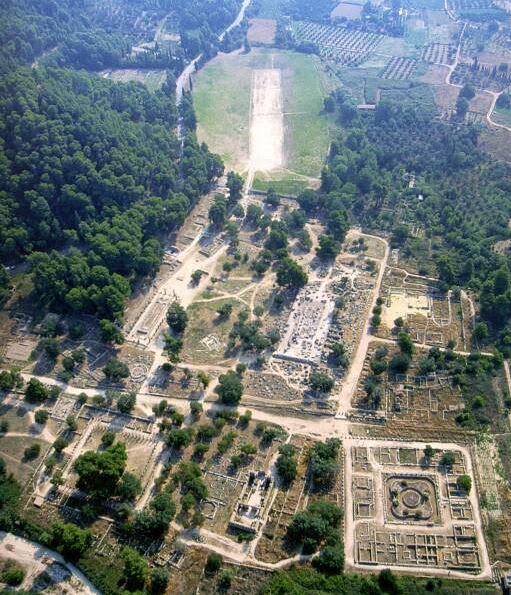
Ancient Olympia Aerial View
The site today is riddled with ruins, with column drums and statues bases surrounded by blooming flowers in spring, and dry grasses in high summer.
However, it is important to remember that ancient Olympia is a living entity. While it has been a sanctuary for ancient traditions from the days of Gods and Titans, it has also been a place of constant change.
One might even say that ancient Olympia was the Greek world in microcosm.
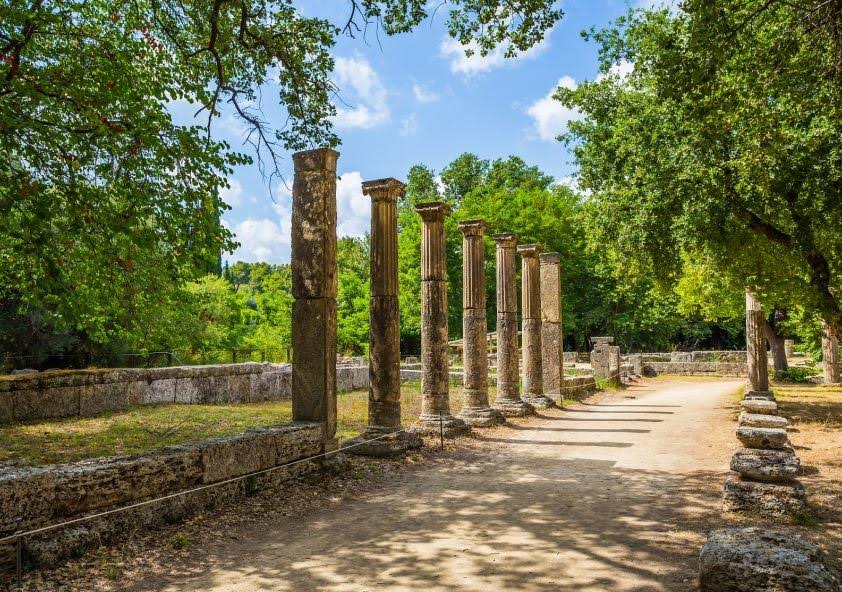
Columns of Palaestra
When one visits the site today, there are many remains of monuments and structures that were not there for the 396 B.C. Olympiad, when Heart of Fire takes place.
The remains of hostels, the south bath house, the Echo Colonnade running along the entire east side of the Altis, and the Exedra of Herodes Atticus were yet to be built. The area of the great gymnasium of Olympia, the massive square of the Leonidaion and its pool, or the round Tholos built by Philip and Alexander of Macedon, known as the Philippeion, were only thoughts in time.
Many of the monumental remains that we see so clearly today were simply not there in 396 B.C.
At the dawn of the fourth century, however, ancient Olympia was thriving. Though many future structures had yet to come into being, many had already been there for over a hundred years.
It goes without saying that the great stadium and hippodrome of Olympia existed in 396 B.C., as did the Archaic temples of Zeus and Hera in the Altis, the religious heart of the Olympic sanctuary, where much of Heart of Fire takes place.
In writing Heart of Fire, I wanted to make the setting for the story as accurate as possible for the time period, so it was important to weed out the Hellenistic and Roman additions to the sanctuary.
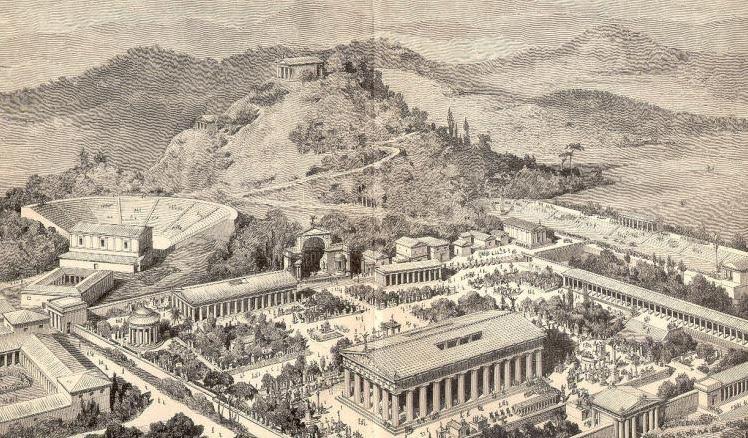
Artist impression of ancient Olympia – many of the buildings in this picture were not there in 396 B.C.
Today, we enter the sanctuary from the North, along the later gymnasium, but in the ancient world, the main entrance to the sanctuary was through the south stoa which faced the line of the Alpheios River.
Behind that was the Bouleuterion, the administrative and ceremonial offices of the Hellanodikai, the official judges of ancient Olympia. It was here that the athletes and coaches took their Olympic oath before a statue of Zeus Horkios (Zeus of Oaths), and sacrificed a wild boar.
All of the religious ceremonies at ancient Olympia were overseen by the Theokoloi, the priests of Olympia, who lived in the Theokoleon, which was located to the West of the Temple of Zeus and the sacred olive grove where crowns were cut. To the northwest of the Theokoleon were the ancient baths and a swimming pool, and to the South of the Theokoleon was the workshop of Pheidias, the sculptor who crafted the chryselephantine statue of Olympian Zeus, one of the Seven Wonders of the ancient world.
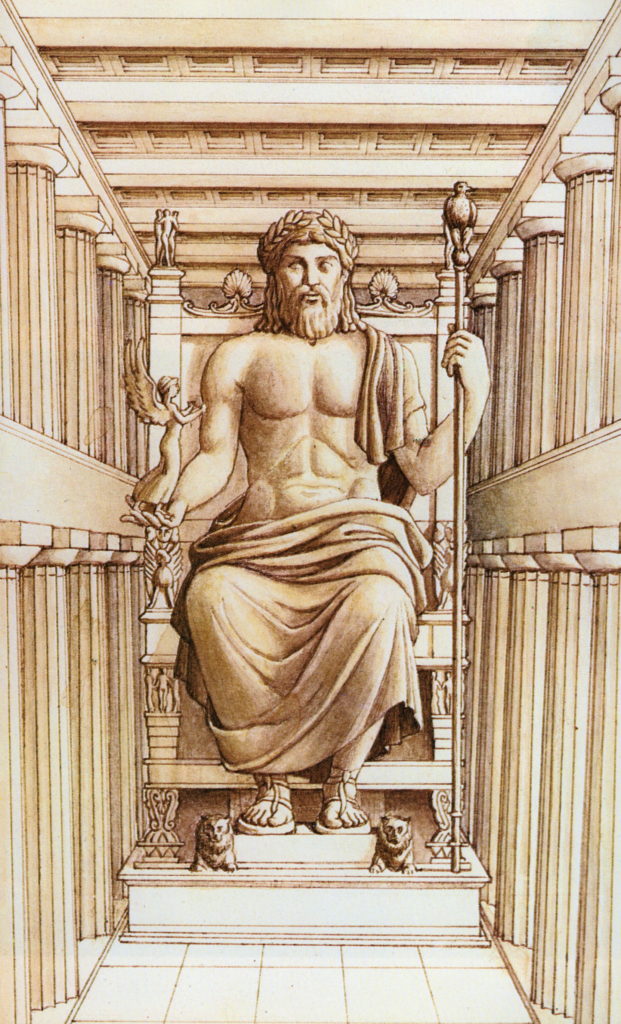
Statue of Zeus
Today, the remains of Pheidias’ workshop are well-intact. Beside this workshop was the house of the Phaidryntai, those whose sacred duty it was to maintain the statue of Zeus built by Pheidias.
The Altis was the inner sanctuary of ancient Olympia, the sacred heart of the place where the Temple of Zeus rose out of the ground, the pediments illustrating the race of Pelops and Oinomaus, and a battle between the Lapiths and Centaurs overseen by Apollo, the first legendary victor in the Games.
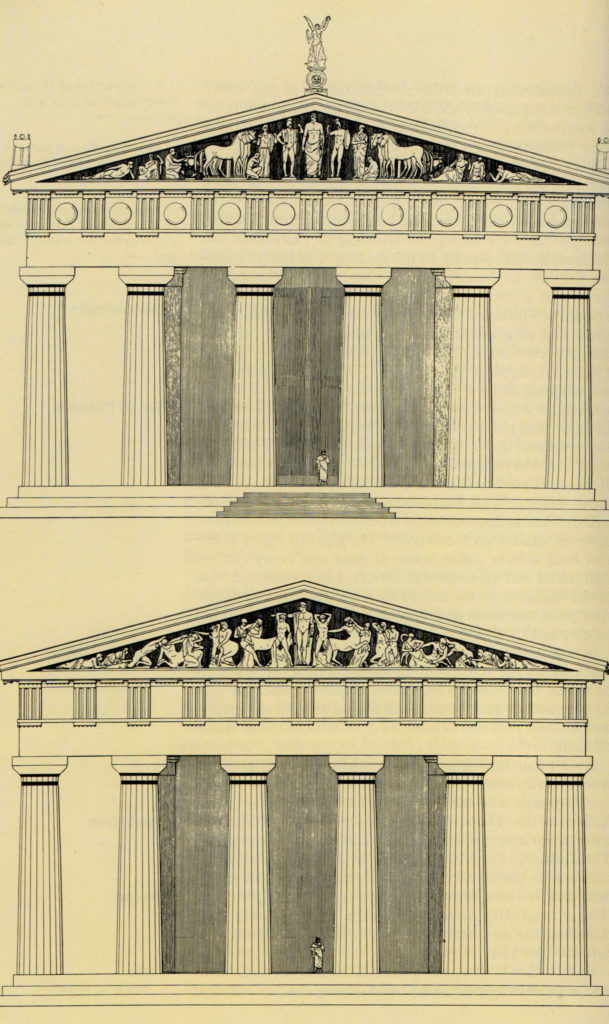
Pediments of the Temple of Zeus at Olympia
Located between the remains of the temples of Zeus and Hera was the Pelopion, the burial mound of the hero Pelops, which stood beside the Great Altar of Zeus, a cone-shaped mound that was built up over time with the bones and ashes of ages of offerings to the King of the Gods.
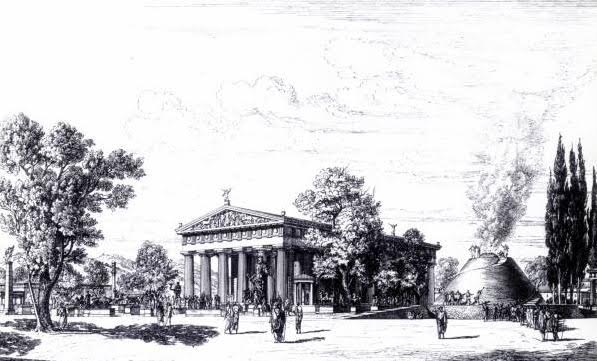
Illustration showing temple and great altar of Zeus
Overlooking the Altis was the Hill of Kronos, and at its base stood the treasuries of various city-states, structures shaped like small temples where offerings were made by those cities, and where citizens of those cities could stay or gather. Before these were the Zanes. These were the statues of Zeus made from fines levied upon those who committed sacrilege and broke the rules of Olympia.
At the northwest corner of the Altis was the Prytaneion. This was the place where the eternal Olympic flame burned at the altar of the Goddess Hestia, and where banquets were given to honour Olympic victors.
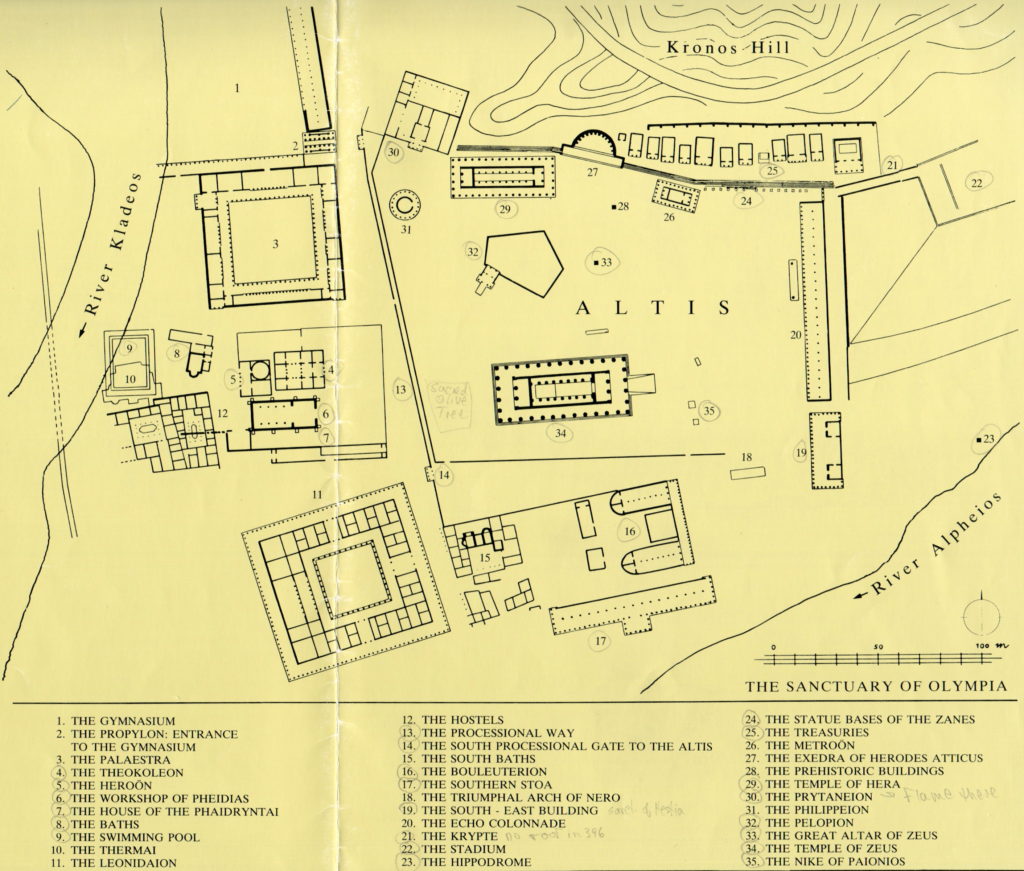
Olympia map my markings – the circles indicate structures that were there in 396 B.C.
As you can see, in 396 B.C. there were many buildings at ancient Olympia. The Altis would have been packed with epinikion statuary, bronze statues erected by Olympic victors as was their right, as well as sixty-nine altars where priests, attendees, and competitors honoured the gods.
After the temples of Zeus and Hera, which now dominate the Altis, most visitors today are drawn to the stadium which stretches out like a sleeping giant on the northeast side.
At one point in time, the vault of the Krypte, the tunnel leading to the stadium, was roofed, similarly so at Nemea. But in 396 B.C. there was no roof over the Krypte.
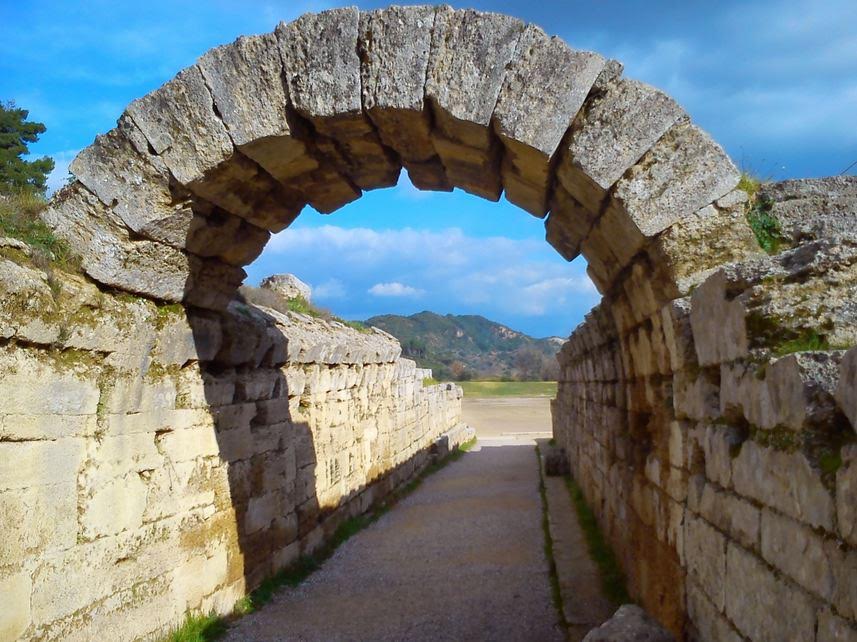
The Krypte which leads into the stadium
The length of an ancient Greek stade, the measurement that gives us the word ‘stadium’, was about two hundred meters. So, the stade race, the original Olympic sprint, was the two hundred meters.
When you step out of the Krypte and onto the dirt of the stadium, it’s quite awe-inspiring to stare down to the other end from the stone starting line which is still there. Through the heat haze you can just see the far end, and on either side the embankments, where over 40,000 Greeks watched the Olympiad, provide a smooth outline. In the middle of the embankment is the area where the Hellanodikai sat, as well as a spot of the Priestess of Demeter Chamayne, the only woman permitted to watch the Games.
It is easy to be tricked into thinking the scene in this serene setting was similar to what it was like in 396 B.C. But nothing could be further from the truth.
It would have been extremely noisy, and smelly with the stink of man-sweat everywhere. One might liken it to a football match today with the various city-state factions being seated together in different sections of the stadium.
Despite a reverence for the gods that most would have shared at Olympia, the Mastigophoroi, the whip-bearing police force of Olympia, must have been busy, especially during the games of 396 B.C. when everyone was still licking their wounds and nursing their bitterness after the Peloponnesian War.
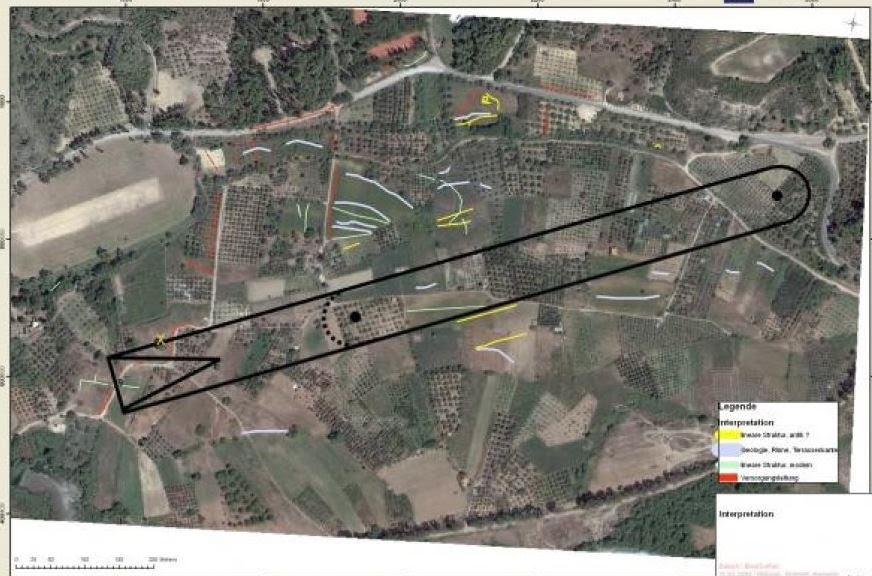
Olympia’s Hippodrome
The Tethrippon, the great four-horse chariot race, is central to the story of Heart of Fire, and this event, as well as the two-horse chariot race, the Synoris, would have taken place in the hippodrome of Olympia.
The hippodrome of Olympia, one of the largest in ancient Greece, was located at the southeast corner of the Olympic sanctuary, along the banks of the Alpheios River. Sadly, the remains of the hippodrome have not been excavated, and a large portion of it has apparently been swept away by the river.
Odd to think of considering that this was a venue for one of the main events of the Olympics, with space for over a hundred thousand spectators. When you gaze across the field in the direction of the hippodrome today, you will not hear the thunder of hooves of the cries of thousands of Greeks, but rather the constant whirr of cicadas, and the flutter of songbirds’ wings among the dry grass. For me, as an author, it was a lot of fun to write about the chariot event of the Olympiad of 396 B.C., an event that made Olympic history.
I will be posting short videos giving a tour of the sanctuary of ancient Olympia, and the sites that play a role in Heart of Fire, so stay tuned for those.
In the meantime, CLICK HERE to watch a fantastic drone video of the sanctuary at ancient Olympia.
The next part in The World of Heart of Fire blog series will look at religion in the Olympic Games.
Thank you for reading!
Part V
Honouring the Gods – Religion and the Olympic Games

Relief of a sacrificial Hecatomb
We’re half-way through our series on The World of Heart of Fire, and I hope you’ve been enjoying the posts thus far.
At this point, I think it apt to stop and look at one of the central aspects of the book, and the ancient Olympics in general: Religion.
It might be difficult for us to imagine today, especially when our modern Olympic Games are more dominated by advertisements and the media in general; we are more likely to associate Adidas and Coke with the Olympics rather than a deep-rooted belief if our chosen god or gods.
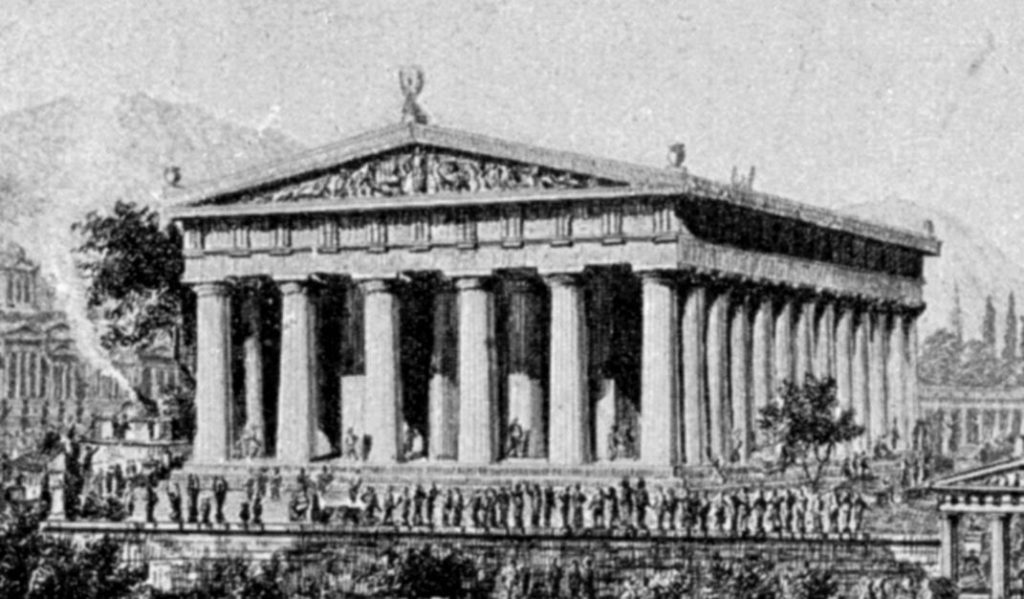
The Temple of Zeus at Olympia
But we are talking about the ancient world here, a time when the occurrence of the Olympic Games stopped wars across the Greek world in honour of the gods.
The Olympic Games were, first and foremost, a religious festival to honour Zeus.
But it is not as straightforward as that.
The concepts of ponos (one’s personal toil), philoneikia (love of competing), and philonikia (love of winning) were, as we have discussed in previous posts, central to a champion’s psyche, and to ancient Greek society in general.
To better oneself, to perfect oneself physically and mentally, was to honour the gods themselves.
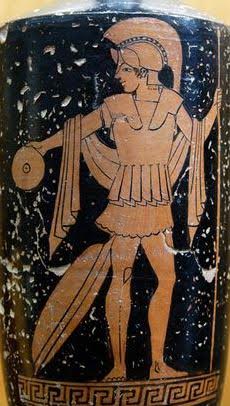
A Greek warrior pouring a libation to the Gods
In order to better understand the ancient world, we need to change our perspective. It’s important to remember that, though many people today don’t even think twice about religion, or believe in any sort of god, this was not so in Ancient Greece, or the rest of the ancient world for that matter.
In the ancient world, people believed the gods were everywhere, that they had a role to play in every aspect of life, whether one was starting a new business, setting out on a journey, going into battle, or lining up at the starting line for an Olympic foot race.
The gods affected everything, and so they were always given their due. The ancient Olympics were no exception to this.
Everything, every event at ancient Olympia was accented with religion and ceremony because the gods themselves were watching.
In the Altis alone there were sixty-nine altars where the Theokoloi, the priests of Olympia, competitors, trainers, and spectators could make offerings to the gods. These were in addition to the magnificent temples of Zeus and Hera which dominated the sanctuary.
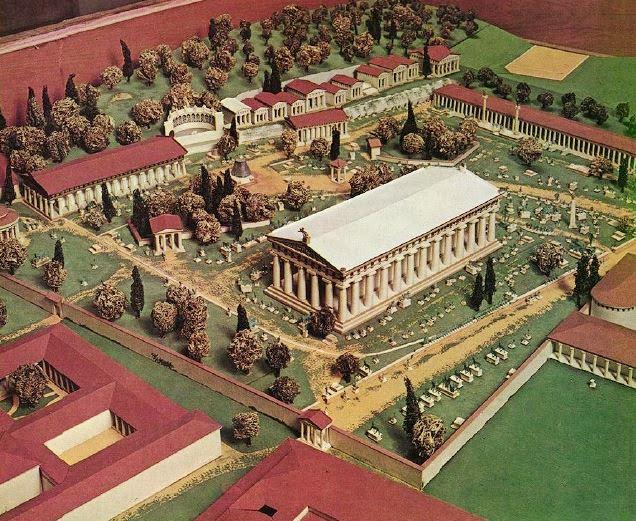
Model of Olympia’s Altis
There was a whole industry of faith at Olympia as well, for in the south stoa and other places, vendors sold votive statues in clay or bronze, including figures of horses, chariots, running men, and tripods. One could also obtain animals for sacrifice, herbs, oils and more.
Individuals would have made offerings with their prayers for victory during their time at Olympia, prior to their events, and afterward.
There were sacrifices and offerings to the gods at the opening of every day, and before events such as the chariot race where an altar lay near the starting gates on the track of the hippodrome.
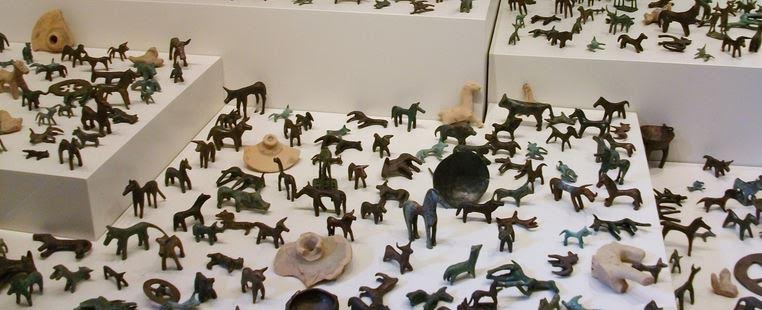
Votive figurines found at Olympia
There were also the marquee religious ceremonies of the Olympic Games which all athletes, trainers and others were expected to attend.
If you have watched the opening ceremony of a modern Olympic Games, you will know that the athletes always take the Olympic Oath.
In the ancient Olympics, the Oath-taking ceremony was a solemn occasion. The ceremony took place at an altar, beside the Bouleuterion, where a wild boar was sacrificed to Zeus Horkios (Zeus of Oaths).
This was overseen by the Theokoloi, and during the proceedings, athletes would swear that they had trained for at least ten months, and that they would compete honourably and not shame the games.
Another part of the Olympics we are all familiar with is the lighting of the Olympic flame.
Just to the northwest of the temple of Hera, was located a square enclosure and buildings called the Prytaneion. This was built in the sixth century B.C. and was used to put on banquets for Olympic victors and other officials.
More importantly, the Prytaneion was where the Eternal Olympic Flame burned beside the altar of the goddess Hestia, the goddess of the hearth and home. This was a sacred place at Olympia, and the fact that victors were celebrated beside the Eternal Flame speaks to the greatness, and divine sanction, of their achievement.
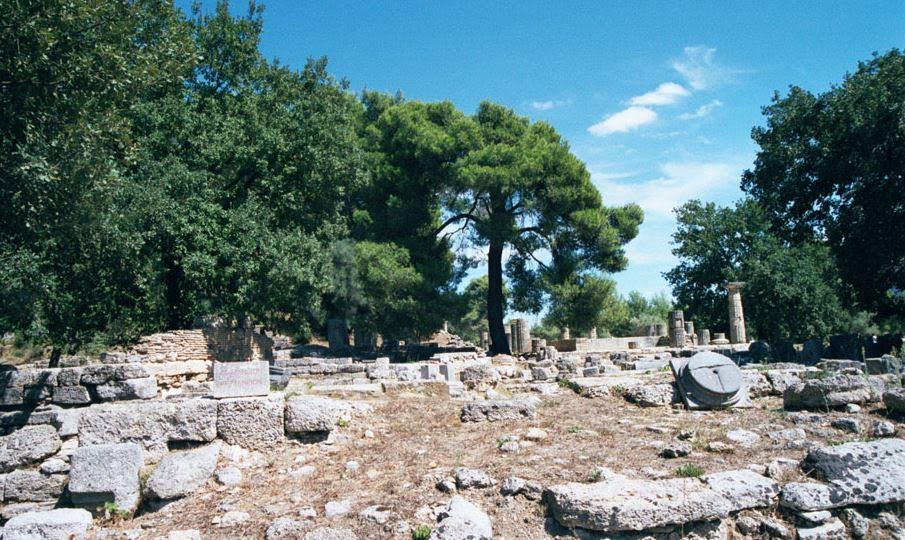
Ruins of the Prytaneion of Olympia
There were also religious relics on-site at ancient Olympia, making it not only a place for competition, but also of pilgrimage, perhaps more so the latter. These relate mainly to the story of Pelops and Hippodameia and that foundation myth of the Olympic Games.
You see, the ancient Greeks firmly believed in the tale of Pelops and Hippodameia, that particular hero-couple being the parents of Atreus, and grandparents of Agamemnon and Menelaus, the kings of Mycenae and Sparta.
To the Greeks visiting Olympia, this was history.
In the temple of Hera there was said to be an ornamental couch that served as a reliquary for Hippodameia’s bones, she who had helped Pelops win against her father and who, in thanks, established the Heraia, the games in honour of Hera in thanks for the victory.
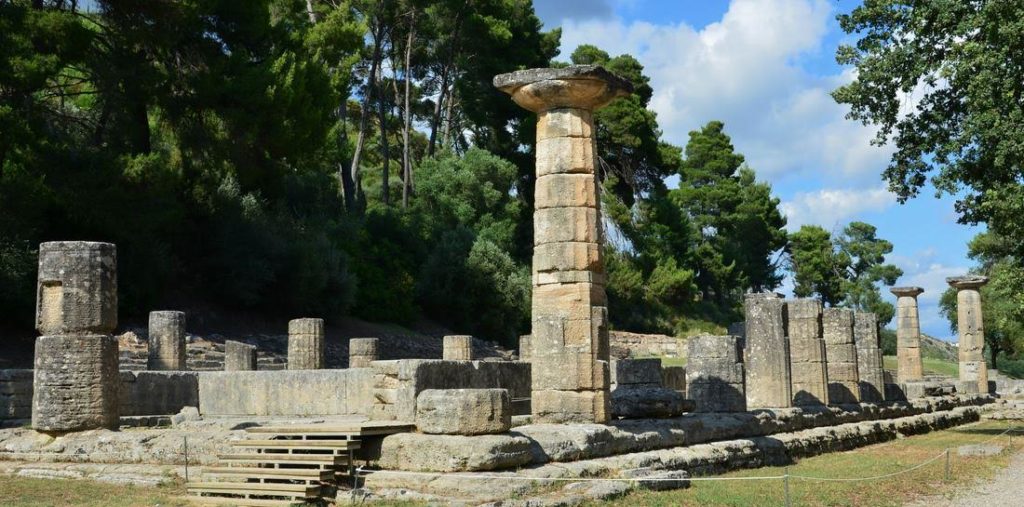
The Temple of Hera
In the treasury of the Sikyionians, at the north end of the Altis, in the shadow of the Hill of Kronos, there were relics of Pelops himself. One of these was his dagger, and the other was an ivory shoulder blade which travelled to Troy and back during the Trojan War.
The shoulder blade was said to be the one that the gods fashioned to replace the original mistakenly eaten by Demeter when Pelops’ wicked father, Tantalus, served his son to the gods at a banquet. The gods resurrected Pelops, and the rest is Olympic myth and history.

Pelops on East Pediment of Temple of Zeus – Pelops is to Zeus’ right, and Oinomaus to the left.
The cult of Pelops was powerful at ancient Olympia. Other than the cenotaphs, memorials, and horse burials that were said to be raised by Pelops and Hippodameia around Olympia, the focus of the cult was the Pelopion.
This was the barrow mound, or burial, of Pelops himself which was located in the middle of the Altis between the temples of Hera and Zeus. Some important scenes in Heart of Fire take place at this monument which was surrounded by a pentagonal enclosure, and where offerings were made to the shade of Pelops.

Pelopion (digital model created by University of Melbourne)
As mentioned before, religious ceremony was central to the Olympic Games, and the greatest of these ceremonies, most agree, happened on the third day of the games.
This was the hecatomb in honour of Zeus.
What is a hecatomb?
Well, it’s the sacrifice of one hundred cattle.
Can you imagine what that must have been like…the sound of one hundred lowing cattle, the tang of blood in the air, and the smoke of the offerings as the bones wrapped in fat were offered to the gods, and the lean cuts were roasted for everyone at Olympia.
This was a solemn ritual that would have kept the Theokoloi and their attendants extremely busy, but it was all for Zeus, King of the Gods, and it did not get more serious than that.
The sacrifices would have taken place at the Great Altar of Zeus which was located in the middle of the Altis. This altar was said to be a large, cone-shaped structure that was made up of piled ash and bones from centuries of offerings.

Illustration showing temple and great altar of Zeus, the cone-shaped structure to the right.
Pausanias describes the Great Altar where the hecatomb was offered to Zeus:
The altar of Olympic Zeus is about equally distant from the Pelopion and the sanctuary of Hera, but it is in front of both. Some say that it was built by Idaean Heracles, others by the local heroes two generations later than Heracles. It has been made from the ash of the thighs of the victims sacrificed to Zeus… (Pausanias Description of Greece 5.13.8)
There can be no doubt that the most important religious structures in the Altis of ancient Olympia were the temples of Zeus and Hera, the king and queen of the Olympian gods. These two ancient structures rose above the mass of altars, statues, and milling crowds, the powerful, archaic columns simple and strong, fitting for the dwelling place of the gods at Olympia.
Though the Games were dedicated to Zeus, Hera was certainly given her due at Olympia.
When Pelops was victorious in his chariot race against Hippodameia’s father, Oinomaus, Hippodameia established the Heraia, the games in honour of Hera, in thanks for the victory. This was the only event for women that was held on the sacred ground of Olympia.
As mentioned, Hippodameia’s bones were kept in a couch inside the temple of Hera, but also kept within that temple were the twenty shields that were used in the Olympic hoplite race, the hoplitodromos.

Temple of Hera artist impression showing the acroterion at the top, shaped like peacock feathers, a symbol of Hera
The centrepiece of the Altis however, was indeed the temple of Olympian Zeus.
This temple contained the titanic chryselephantine statue of Zeus, created on site by the sculptor Pheidias, whose workshop was just outside the Altis. The statue was made of ivory and gold and portrayed Zeus seated on his throne with the goddess Nike in his hand, that goddess who crowned the victors.
Now you know where the shoe company gets its name!
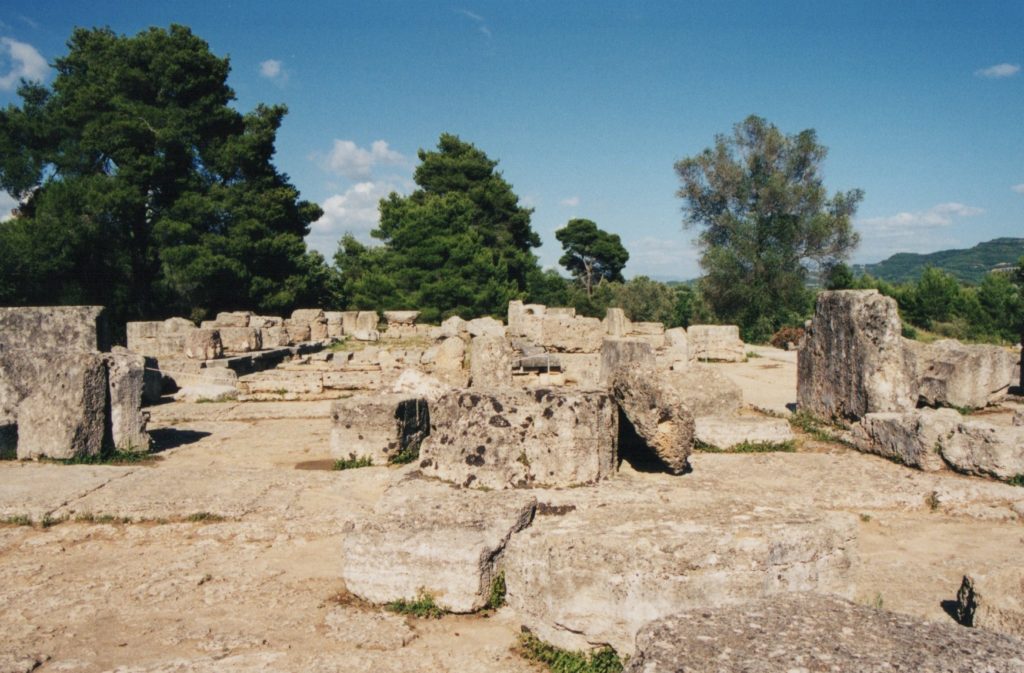
Temple of Zeus ruins
The victory ceremony was a solemn religious occasion that happened after a competitor was proclaimed ‘best among the Greeks’ and given a linen headband as a sign of their victory.
After that, there was a procession of victors through the Altis to the temple of Zeus, with onlookers showering the victors with phylobolia, fresh flowers and greens.
Before Zeus, men were crowned with the sacred olive crowns in a ceremony called the ‘binding of the crown’. These crowns were made from boughs of the sacred olive trees that were located near the temple of Zeus.
It may be hard for us to imagine this moment, when an ancient athlete was crowed before the gods. It was indeed a deeply religious moment, with the singing of hymns in honour of Herakles, Zeus’ son.
It was believed that men won, not only by skill and training, but more so by divine grace. Sacrifices were made at this time, and then victors enjoyed a meal in the Prytaneion in the presence of the eternal Olympic flame.

Nike, Goddess of Victory, Crowning an Olympic Victor
Of course, ancient sources are sparse, and the exact details of every aspect of ceremony at the ancient Olympics cannot be known for sure. However, what has come down to us paints enough of a picture to help us understand that the ancient games were not just about running and pounding away at one’s opponent.
Attending the ancient Olympics, for ancient Greeks, was a pilgrimage that deserved respect, a sacred rite to honour the gods through skill and performance, and, if the gods smiled, through victory.
If you ever get a chance to walk the grounds of ancient Olympia, you will certainly get a sense of the deep connection between religion and the Olympic Games.
In the next post, we will look at one of the oldest Olympic sports that plays a big role in Heart of Fire: Boxing.
Thank you for reading!
Part VI
Boxing in the Ancient Olympic Games
In Part VI of The World of Heart of Fire, we are going to look at the chosen sport of one of the main characters, the Argive mercenary, Stefanos, son of Talos.
Without giving anything away, Heart of Fire involves a climactic boxing match set during the Olympics of 396 B.C.
When I set out to write this book, I was really only familiar with modern boxing, and I knew that ancient boxing was quite different. So, I thought it would be good for us to take a look at this ancient pugilist sport.
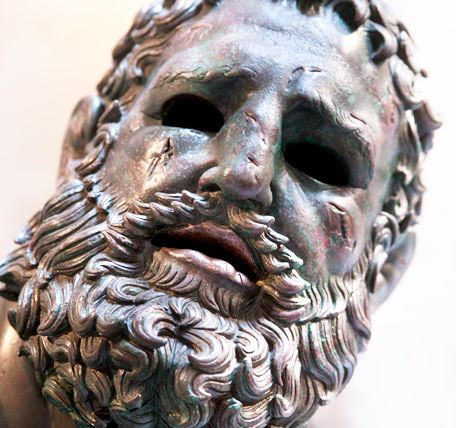
Hellenistic bronze boxer from Rome shows wounds and lascerations to the fighter’s face
Now, I’ve written more fight scenes than I can count in my stories, some very realistic, others fantastical, some ugly, some inspiring. Most of the time, they have been fought with weapons.
However, boxing is a more visceral sport, especially ancient Greek boxing.
In Heart of Fire, I knew I had to make the fights count, that I wanted to put the reader ‘ringside’ so that she/he could taste the sweat and blood, and feel the impact of every hit.
I’m not a boxer, and though I’ve taken part in some martial arts, I had to admit that I had no idea how a man, or his body, would react during an ancient Greek boxing match.
You see, ancient boxing was not like modern Olympic boxing.
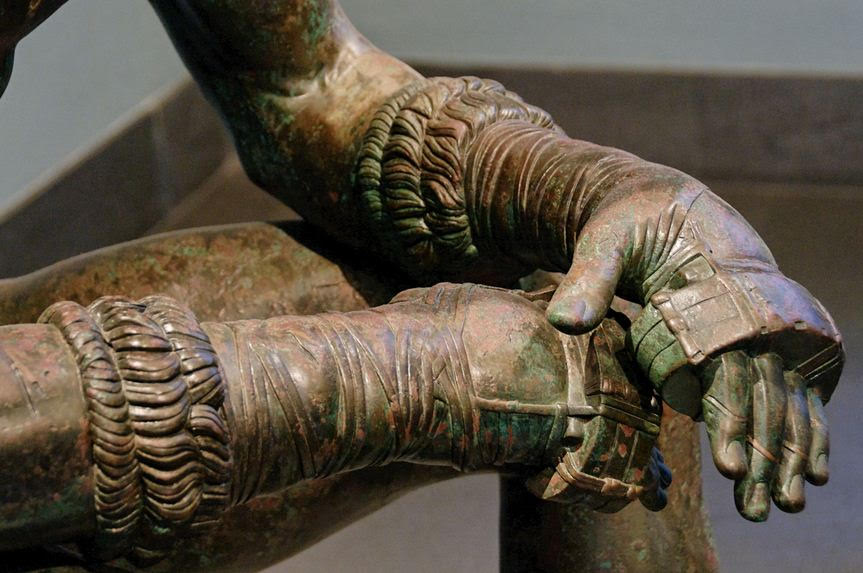
Himantes – from Hellenistic bronze of a boxer
First of all, the ancient Greeks did not cover their fists with soft, padded gloves. Instead, they used something called himantes. These were thick strips of leather, rawhide, or sometimes lead, that were fastened to a fighter’s fists with linen or leather straps. The fingers were not covered, but left free to grab, to poke and jab, as well as punch.
In modern boxing, there are basically four punches: the direct or straight punch, the upper cut, the jab, and the hook. Combinations of these are used variously.
In contrast, ancient boxing included many more types of hits, including slaps, hammer punches, backhands, chops, pokes, elbows, swipes and many more.
Truthfully, ancient boxing was more like Wing Chun Kung Fu arm techniques than modern boxing. It differed from the pankration mainly in that there were no holds or grappling, and perhaps fewer intentional bone-breaking moves.
Before writing, I had to dispel with my modern ideas of boxing and what it should look like. Also, there were no ‘rounds’ in ancient boxing. The two fighters went at each other until someone was knocked out, or until one of the fighters surrendered. If neither of those two things happened, and if no one died, a fight could go on all day.
When writing an ancient boxing scene, in addition to being accurate, each fight also has to propel the story forward. I started by looking at some famous movie fights, and what better boxing match to look at than the last bout in Rocky I.
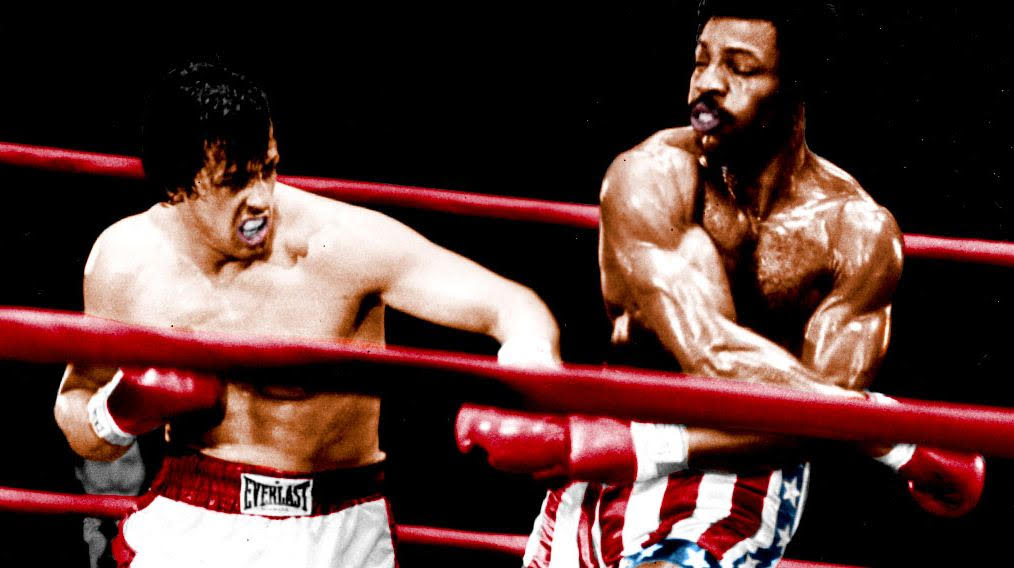
Rocky I – Rocky vs. Apollo Creed
It’s one of the most famous modern boxing scenes in movie history and it showed me how the story can be told without speech, but rather the actors’ bodies, how the strain and struggle tell a story without words. It illustrates the all-important, ancient idea of ponos, the toil and passion of an athlete or warrior.
So, Rocky helped me visualize the storyline of my fight scene, and how it would move the characters forward. Next however, I needed to visualize how ancient boxing might look mechanically.
Of course, I can make some pretty good guesses and get creative – that’s the joy of writing after all – but I wanted to find at least a small demonstration to help it sink in. Luckily, I found a video from the Historical European Martial Arts Coalition (HEMAC) conference in Dijon France, demonstrating the art of ancient Greek boxing.
CLICK HERE to watch the video.
This is a short video, but I found it very helpful. The men sparring are holding back a little, as it is a demonstration only, but you can easily imagine what it might be like with the rawhide, or lead pieces inserted in the himantes, and the fighters hitting one another full force.
It would be brutal, and oftentimes, quick.
If you’ve seen some of the top 20 boxing knock-out videos on YouTube, you’ll know that with one hit to the head, a massive, strong man can crumple like a rag doll. It’s not pretty.
Take off the modern, padded gloves, and substitute them for ancient himantes, and you’ve got yourself a genuine ancient bloodsport.
If you want to learn a bit more about the sorts of injuries that might occur in an ancient boxing match, CLICK HERE to read a fascinating article.
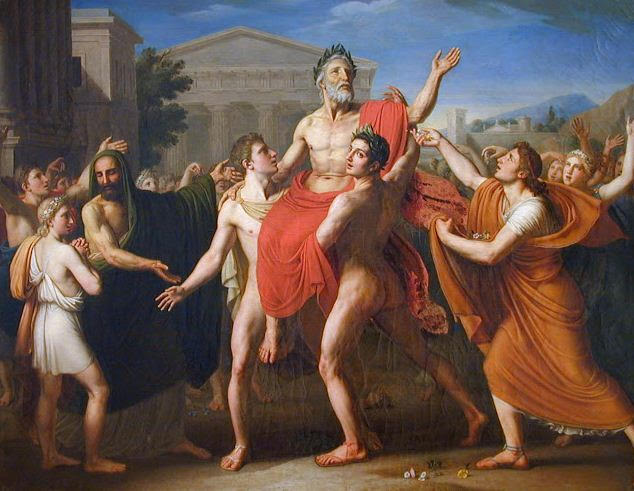
The Diagorids of Rhodes were boxing royalty in Ancient Greece … as Degeorge, Diagoras porté en triomphe par ses fils, 1814
The men who emerged victorious in boxing at the ancient Olympiad trained hard, as if for war, and if they walked off the skamma, the sand, as the victor, they were able to achieve the sort of immortality reserved for demi-gods and heroes.
I hope you enjoy the boxing scenes in Heart of Fire. Though the book is not specifically about boxing, I did enjoy researching and writing them.
Hopefully, when you do read it, you will feel like you are right there, hearing the bones crack.
In the next post, we are looking at the other sport that takes centre stage in Heart of Fire at the Olympics of 396 B.C. – the chariot race.
Thank you for reading.
Part VII
From Legend to Life – Chariot Racing at the Ancient Olympiad
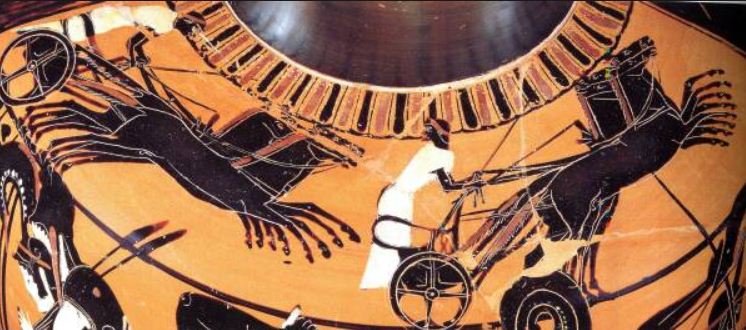
Olympic Chariot Race – The Most Popular Event of the Games
In this seventh post of The World of Heart of Fire, we are going back to the legend of Pelops and Hippodameia, to a time of gods and heroes.
In the previous post, we looked at boxing in the ancient Olympics and how it differed from today.
In this post we are going to explore the sport of ancient chariot racing, an event that is central to the story of Heart of Fire.
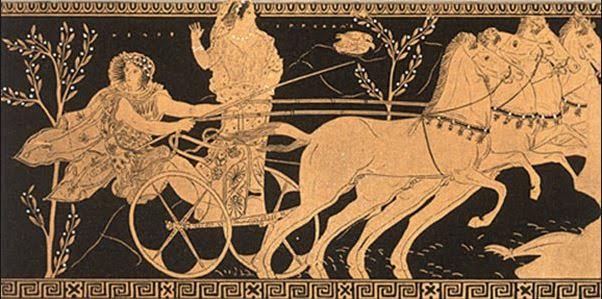
Pelops and Hippodameia racing
The foundation myth of the Olympic Games as it relates to Pelops involves the latter’s chariot race from Olympia to Argos, for the hand of Hippodameia in marriage.
Hippodameia’s father, Oinomaus, was apparenlty quite brutal, and every suitor who came for his daughter’s hand in marriage had to try and beat him in a chariot race across what became known as the Peloponnese, or, the ‘Isle of Pelops’.
Eighteen suitors had raced Oinomaus and been killed by him before Pelops laid down his challenge.
According to the legend, Pelops was trained by Poseidon himself about horses, and given a team of swift-footed horses by the god so that he could succeed in beating Oinomaus.
In order to ensure that Oinomaus did not win, Hippodameia also convinced her father’s man, Myrtilus, to replace the wheel pins with wax ones so that Oinomaus’ chariot would crash.
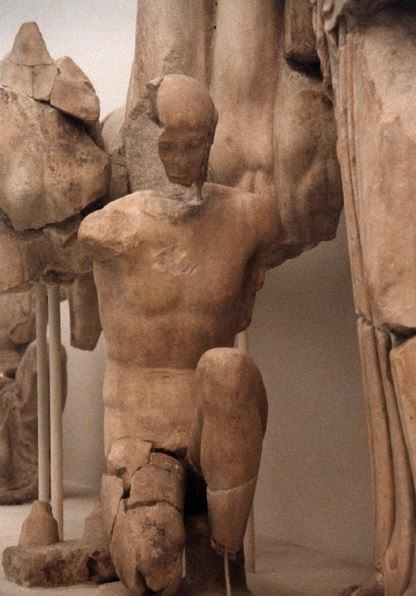
Figure of Mytilus on East Pediment of Temple of Zeus – See him kneeling to switch the pins of Oinomaus’ chariot wheel?
The Theban, epinikion poet, Pindar, describes the contest:
Then he [Pelops] said unto him: ‘Lo now, O Poseidon, if the kind gifts of the Cyprian goddess are anywise pleasant in thine eyes, restrain Oinomaus’ bronze spear, and send me unto Elis upon a chariot exceeding swift, and give the victory to my hands. Thirteen lovers already hath Oinomaus slain, and still delayeth to give his daughter in marriage. Now a great peril allopath not of a coward: and forasmuch as men must die, wherefore should one sit vainly in the dark through a dull and nameless age, and without lot in noble deeds? Not so, but I will dare this strife… (Pindar, Olympian Ode 1)
After Pelops’ victory, it was said that he began the Olympic Games in thanks to Zeus for his win. Another theory is that the Olympics were begun by Pelops as funeral games for the deceased Oinomaus who died in the race, or for Myrtilus, whom Pelops had killed.
Whatever the ‘truth’ about these Olympic beginnings, one thing is certain – Chariot racing and horses had a deep connection to the Games.
As far as we know, the very first event of the Olympic Games was the stade race sprint. As mentioned before, boxing became a part of the Olympic roster in the fourteenth Olympiad.
So when did chariot racing become a part of the Games?
It is generally agreed that chariot racing first made an appearance in the ancient Olympics during the twenty-fifth Olympiad in the year 680 B.C., almost three hundred years before Heart of Fire takes place.
In the ancient Olympics, there were two types of chariot race that took place in the hippodrome of Olympia – the synoris (two-horse chariot race), and the tethrippon (the four-horse chariot race).
In Heart of Fire, we are concerned with the tethrippon race, which was the marquee event of the ancient games.
However, this was not like the chariot racing you’ve seen in the movies. Forget about Ben Hur, and the massive chariots that were pulled around the track in that classic movie.
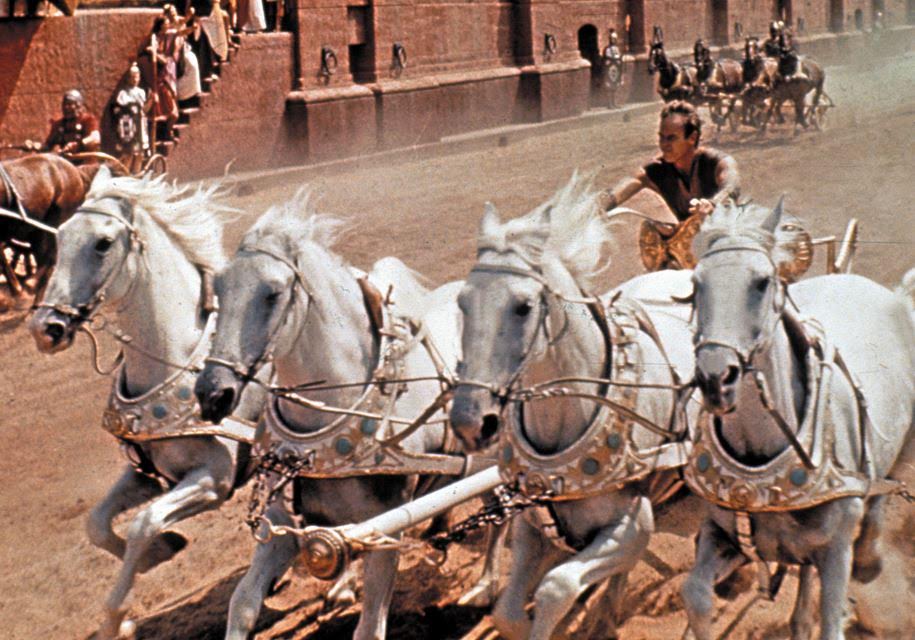
The Chariot Race scene from the movie Ben Hur
Ancient Olympic chariots were meant for speed. They were basically a small platform on wheels, with a skinny rail, and yoked to the horse team of two or four.
Ancient chariots were small, light, and fast, and driving them required a lot of skill. It wasn’t just about controlling the horses. A charioteer had to know his team well, to determine their strengths and weaknesses, where they could pull ahead of the pack, and how to keep them out of danger without giving ground.
In ancient chariot racing, the drivers did not compete naked like the rest of the Olympic athletes. Rather, they wore a long, Ionic chiton called a xystis which was belted high with leather straps criss-crossing over the back and chest so as to prevent the garment from ballooning out at speed and slowing the team down.
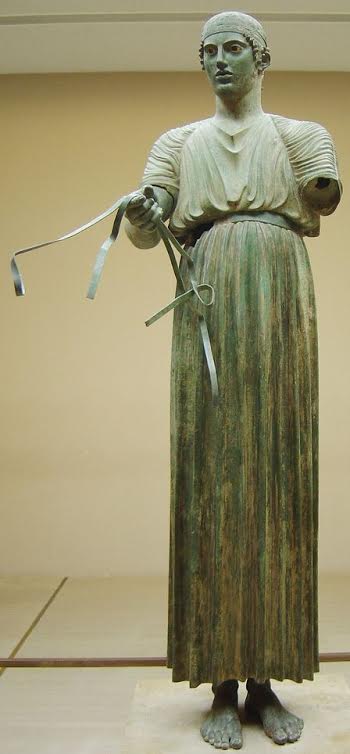
The Charioteer of Delphi
The hippodrome at Olympia, which lies somewhere at the southeast corner of the sanctuary, was about four stades long (780 meters), and one stade, four plethra wide (320 meters).
When visiting Olympia the stadium seems big, but you can imagine how it would have been dwarfed in size by the hippodrome.
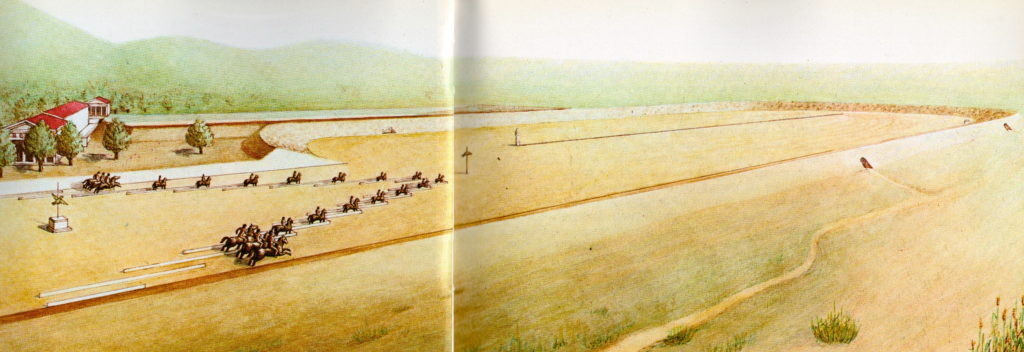
Artist impression of the Olympic Hippodrome and Hyspleges
Once again, the ancient writer, Pausanias, gives us a description:
When you have passed beyond the stadium, at the point where the umpires sit, is a place set apart for the horse-races, and also the starting-place for the horses. The starting-place is in the shape of the prow of a ship, and its prow is turned towards the course. At the point where the prow adjoins the porch of Agnaptus it broadens and a bronze dolphin on a rod has been made at the very point of the ram.
Each side of the starting-place is more than four hundred feet in length, and in the sides are built stalls. These stalls are assigned by lot to those who enter for the races. Before the chariots or race-horses is stretched a cord as a barrier. An altar of unburnt brick, plastered on the outside, is made at every Festival as near as possible to the center of the prow, and a bronze eagle stands on the altar with his wings stretched out to the fullest extent. The man appointed to start the racing sets in motion the mechanism in the altar, and then the eagle has been made to jump upwards, so as to become visible to the spectators, while the dolphin falls to the ground.
First on either side the barriers are withdrawn by the porch of Agnaptus, and the horses standing thereby run off first. As they run they reach those to whom the second station has been allotted, and then are withdrawn the barriers at the second station. The same thing happens to all the horses in turn, until at the ram of the prow they are all abreast. After this it is left to the charioteers to display their skill and the horses their speed.
(Pausanias, Description of Greece, 6.20)
The hippodrome could accommodate over one-hundred thousand spectators along its embankments, and one can imagine the roar of the crowd combined with the pounding of hooves of twenty to forty chariot teams. It would have been spectacular!
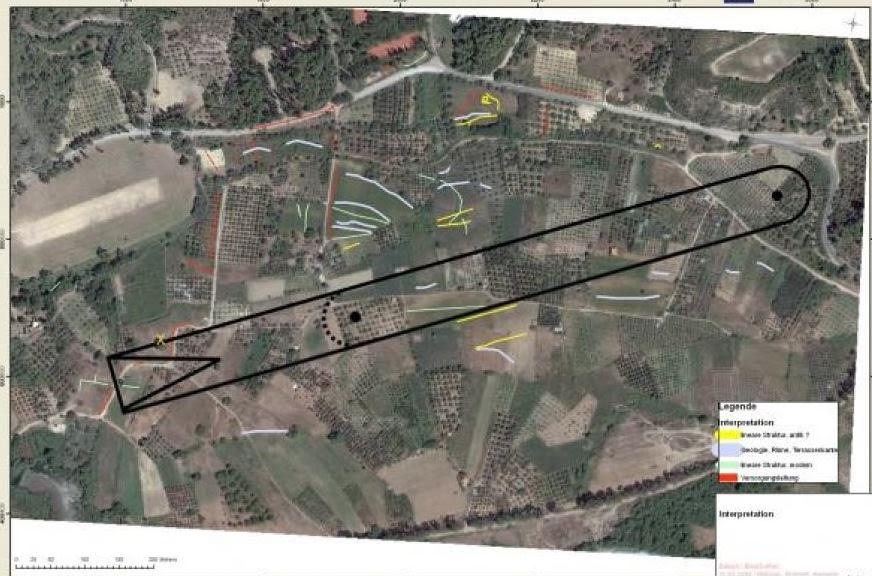
Olympia’s Hippodrome shown in supposed location
The Hellanodikai, the judges, sat on the West side of the hippodrome, and, as ever, there were sacrifices before the race. As the marquee event of the Games, there was a lot of ceremony around this event.
Once the charioteers brought their teams into the hippodrome, a sacrifice was performed at an altar on the track. Then the teams made a slow circuit of the track so that the spectators could see them and hear their names, and those of their cities, announced.
When the introductory circuit was complete, each team lined up in his appointed starting gate, or hysplex, which was overlooked by a statue of Hippodameia high above them.
What is fascinating is that the ancient Greeks had engineered the starting gates (hyspleges) so that each team shot off the line at the same time, but in order to do this, they staggered the positions so that the teams at the rear were released first and all reached the lead team just as their rope dropped. This was a great piece of ancient ingenuity!

The Olympic starting gates, or ‘hyspleges’
The Tethrippon, or the four-horse race, involved twelve laps of the massive course. The deadliest parts of the hippodrome course were the nyssa, the turns where so many accidents tended to happen.
One of the turns in particular at Olympia was especially dangerous because it was said to be haunted by an evil spirit, some say the wicked shade of Oinomaus, the cruel father of Hippodameia who had killed so many of her suitors. This turn was called the Taraxippos, which literally means ‘horse-frightener’.
The race-course has one side longer than the other, and on the longer side, which is a bank, there stands, at the passage through the bank, Taraxippus, the terror of the horses. It has the shape of a round altar, and as they run along the horses are seized, as soon as they reach this point, by a great fear without any apparent reason. The fear leads to disorder; the chariots generally crash and the charioteers are injured.
(Pausanias, Description of Greece 6.20)
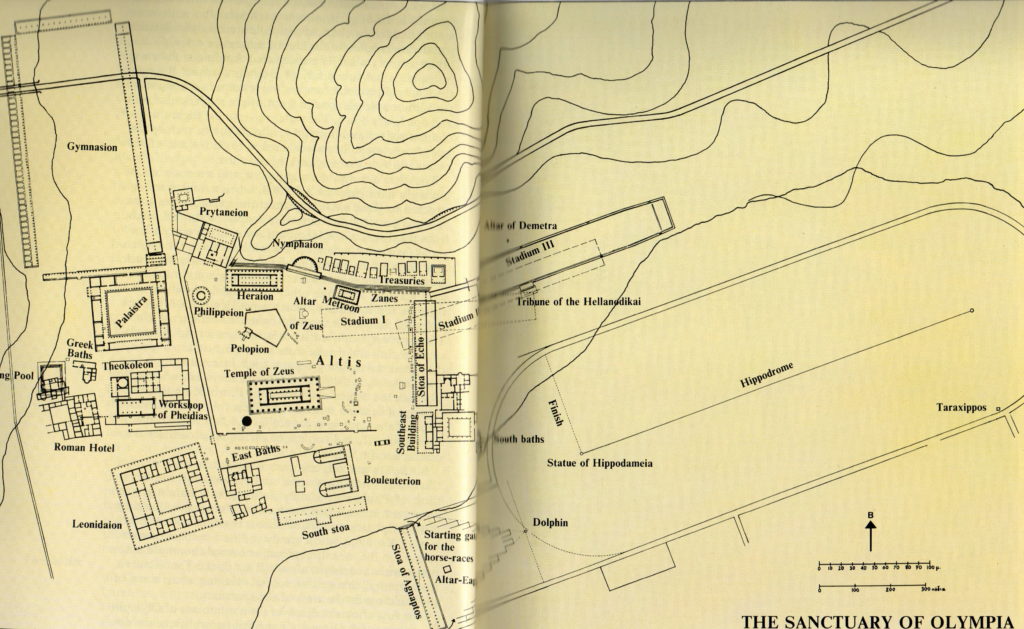
Olympia map showing hippodrome
After each lap of the course, one of twelve suspended bronze dolphins tipped over or dropped to indicate the completion of that lap, allowing the drivers and the spectators to see where they were in the race.
The climactic scene of Heart of Fire, and one of the most fun and challenging for me to write, was the chariot race of the 396 B.C. Olympiad.
This was a games that went down in Olympic, and Ancient Greek, history.
In the next post, we’ll find out why the 396 B.C. Olympics were so important, and how one person managed to change the face of sport forever.
Thank you for reading!
Part VIII
Kyniska of Sparta – The Woman who made Olympic History
SPOILER ALERT!
Before you read further…
If you have not yet read Heart of Fire – A Novel of the Ancient Olympics, and you are planning on doing so, you may wish to read the book first, before you continue with this blog post.
The events discussed here, in Part 8 of The World of Heart of Fire, involve the climax of the book, and so your experience in reading the story might be lessened somewhat if you continue.
However, if you have already read Heart of Fire, or are just here to read about the history, then please do carry on. I hope you enjoy it!
In Part 7 of this blog series, we discussed chariot racing at the ancient Olympics. However, we did not touch on why that event was so pivotal to the Olympiad of 396 B.C.
We have mentioned before how only men were permitted to compete in the Olympic Games in the ancient world. However, there was one event in which women were permitted to compete – the chariot race.
Though women were not allowed to enter the Olympic sanctuary during the Games, they were allowed to compete as the owners and trainers of horses in the chariot races.
It was in the year 396 B.C. that Princess Kyniska of Sparta exploded onto the scene and made Olympic history.
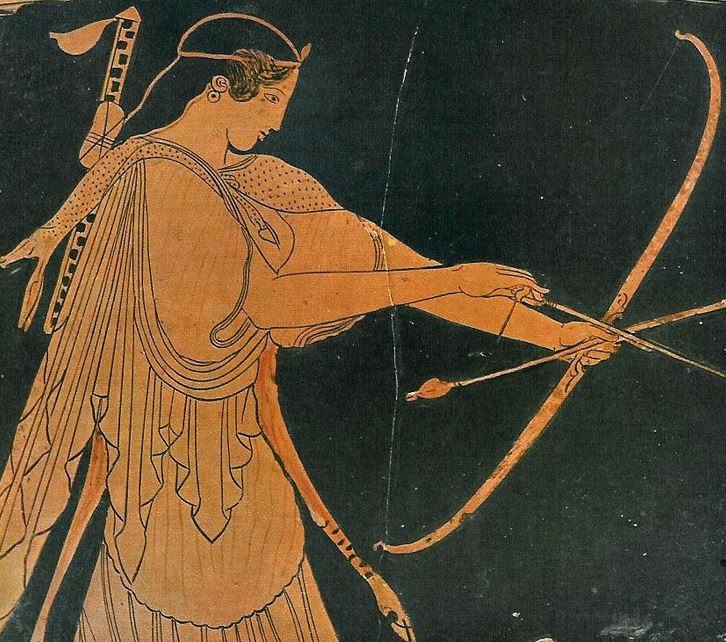
Goddess Artemis
The very first time I read about Kyniska (also spelled Cynisca), I knew I had to write this book. There was absolutely no doubt in my mind. I was inspired by her story, though very little detail has come down to us about this fascinating woman who rocked the world of men.
You see, in 396 B.C. Kyniska was the first woman to compete in and win in the marquee tethrippon event at Olympia, the four-horse chariot race.
At this Olympiad, which came on the tail of several years of brutal civil war among the Greeks, and at a time when many Greek city-states reviled Sparta, Kyniska came forward like a force of nature.
But who was this amazing woman?
Kyniska of Sparta was the daughter of King Archidamus II of Sparta (476-427 B.C.), the Eurypontid King of Sparta. She was also the half-sister of King Agis, and sister to King Agesilaus II (444-360 B.C.) who waged war on both the Persians and his fellow Greeks.
Archidamus left sons when he died, of whom Agis was the elder and inherited the throne instead of Agesilaus. Archidamus had also a daughter, whose name was Cynisca; she was exceedingly ambitious to succeed at the Olympic games, and was the first woman to breed horses and the first to win an Olympic victory. After Cynisca other women, especially women of Lacedaemon, have won Olympic victories, but none of them was more distinguished for their victories than she.
(Pausanias, Description of Greece, 3.8)

Artist impression of Kyniska driving chariot
It is believed that Kyniska was born sometime around 440 B.C. in Sparta and, unlike other Greek women beyond Sparta, she grew up training herself physically and mentally as was expected of strong, Spartan women.
In Sparta, it was believed the woman should be fit and healthy as well, and they trained naked at sports, riding and hunting, just like the men. In Sparta’s eyes, how else could they give birth to perfect Spartan warriors?
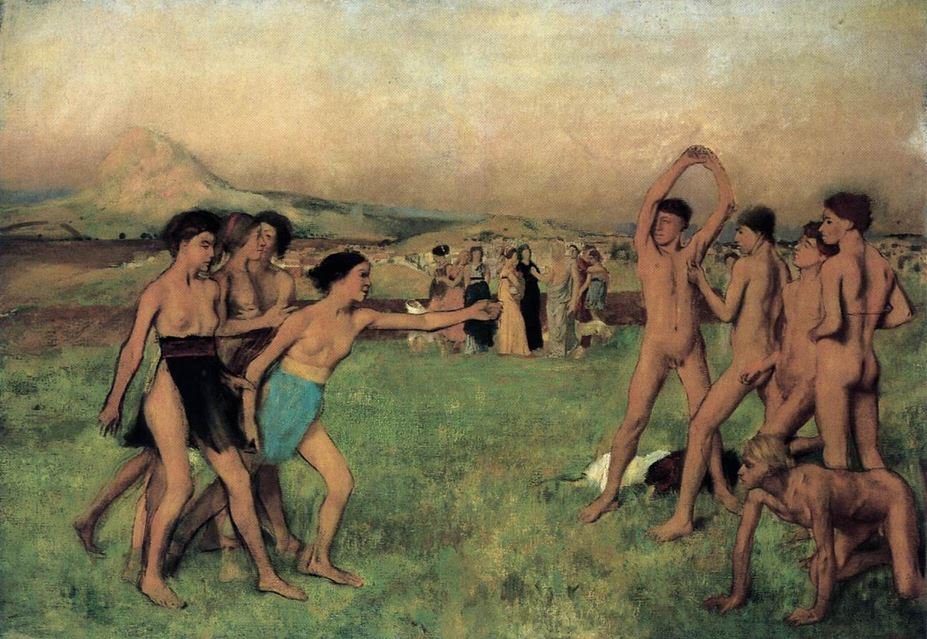
Young Spartans Exercising (Edgar Degas)
But Kyniska was destined for other things that giving birth to new Spartan warriors.
She was an expert equestrian, a sort of ancient horse-whisperer learned in the breeding and training of horses. As the wealthy daughter of a king, the rearing of horses would have been accessible to her.
After years of raising and training horses, Kyniska finally entered a team in the great four-horse chariot race of the 396 B.C. Olympics.
Sadly, the ancient sources mention Kyniska only in passing, and even then, with the exception of Pausanias, it is in relation to her brother, King Agesilaus II.
Xenophon, the great leader of the 10,000, and author of the ancient work On Horsemanship, mentions Kyniska in his work on his very good friend Agesilaus:
Surely, too, he [King Agesilaus] did what was seemly and dignified when he adorned his own estate with works and possessions worthy of a man, keeping many hounds and war horses, but persuaded his sister Cynisca to breed chariot horses, and showed by her victory that such a stud marks the owner as a person of wealth, but not necessarily of merit. How clearly his true nobility comes out in his opinion that a victory in the chariot race over private citizens would add not a whit to his renown; but if he held the first place in the affection of the people, gained the most friends and best all over the world, outstripped all others in serving his fatherland and his comrades and in punishing his adversaries, then he would be victor in the noblest and most splendid contests, and would gain high renown both in life and after death.
(Xenophon, Agesilaus 9)
We need to remember that in this man’s world, the men wrote the history, and as a friend of Agesilaus’, Xenophon would have sought to please the king in his writing.
It was said that Agesilaus told Kyniska to compete in the Olympics simply to win and then discredit the sport of chariot racing by showing that even a woman could win it. Given Agesilaus’ character, this seems more likely than a willingness to display his sister’s abilities, or to raise the status of women in general.
At this time in history, in Ancient Greece, even a Spartan woman was just a woman. Men ruled this world, and women had their place.
But that is why Kyniska’s story is so compelling!
Sure, it’s easy from our modern vantage point to romanticize Kyniska and her achievements, but let us remember that, even though she did not drive the chariot, she would have met resistance every step of the way.
In Sparta, the use of horses for war was not common, and chariot racing as a sport was frowned upon. Kyniska must have been quite determined to go to the Olympic Games if she raised and trained her chariot team.
If King Agesilaus was seeking to discredit the sport of chariot racing by having his sister compete, his attempts were in vain. At that time, chariot racing was the marquee event of the Olympiad, and it only grew in popularity over the years until it reached its peak as a sport centuries later in the hippodromes of Rome and Constantinople.
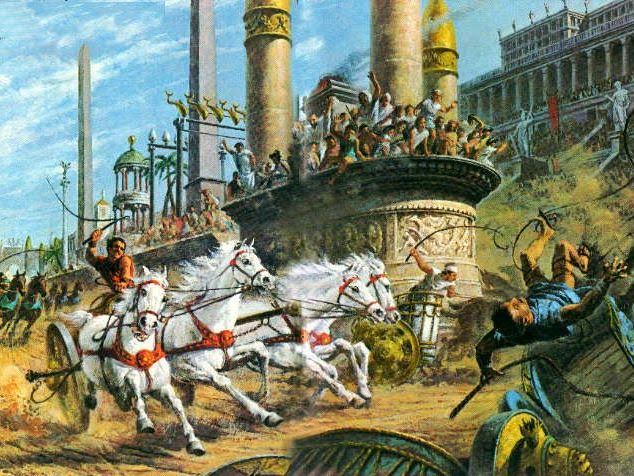
Roman Chariot Race in the Circus Maxiums
When Kyniska of Sparta arrived outside the sanctuary of Olympia in 396 B.C. to have her team compete in the Olympic Games, one can imagine the rich men of every other city-state, perhaps even her own, scoffing at the thought of such a thing, of a woman owning, breeding, and training horses.
But it seems the gods were with Kyniska of Sparta on that fateful summer day in 396. Her team drove to victory in the Olympic tethrippon, and surely, the shockwaves of such a triumph must have been felt across the Greek world, a world in which an Olympic victory could bring a mortal as close as possible to immortality.
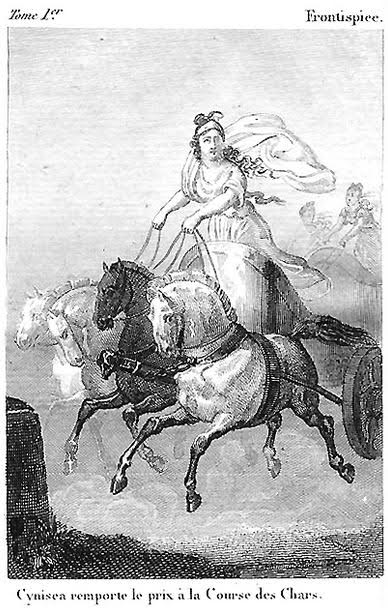
Old print of Kyniska
As was the right of every Olympic victor, Kyniska was permitted to erect a victory bronze for herself in the Altis of Olympia, along with the images of the champions of ages past.
According to Pausanias, her statues included one of herself, and a bronze equestrian group. As fortune would have it, the statue base survived to give us this inscription:
Kings of Sparta are my father and brothers,
Kyniska, victorious with a chariot of swift-footed horses,
have erected this statue. I declare myself the only woman
in all Hellas to have won this crown.
Apelleas son of Kallikles made it.
From these few words, it seems obvious that Kyniska was proud, and well-aware of the enormity of her victory. She had previously been a winner in the foot race of the Heraian Games, and now she was an Olympic champion, the only woman ever to have won the sacred olive crown.
I have chills writing about this, to think that that was the moment in which the door to athletic competition had been opened for women, and in such a masculine world. It is humbling, and mind-blowing, and it reminds me of why I wanted to write Heart of Fire.
As if to solidify her immortality, Kyniska returned to Olympia in 392 B.C. to claim a second victory in the tethrippon.
After this Spartan princess, other women, not only of Sparta, entered and won in the chariot races of Olympia and other games, one of them Euryleonis, in 368 B.C., who makes an appearance in the story of Heart of Fire. The victors were not only women of Sparta, like Kyniska and Euryleonis, but women of other city-states, including Belistiche, Zeuxo, Encrateia, Hermione, Timareta, Theodota of Elis, and Cassia.
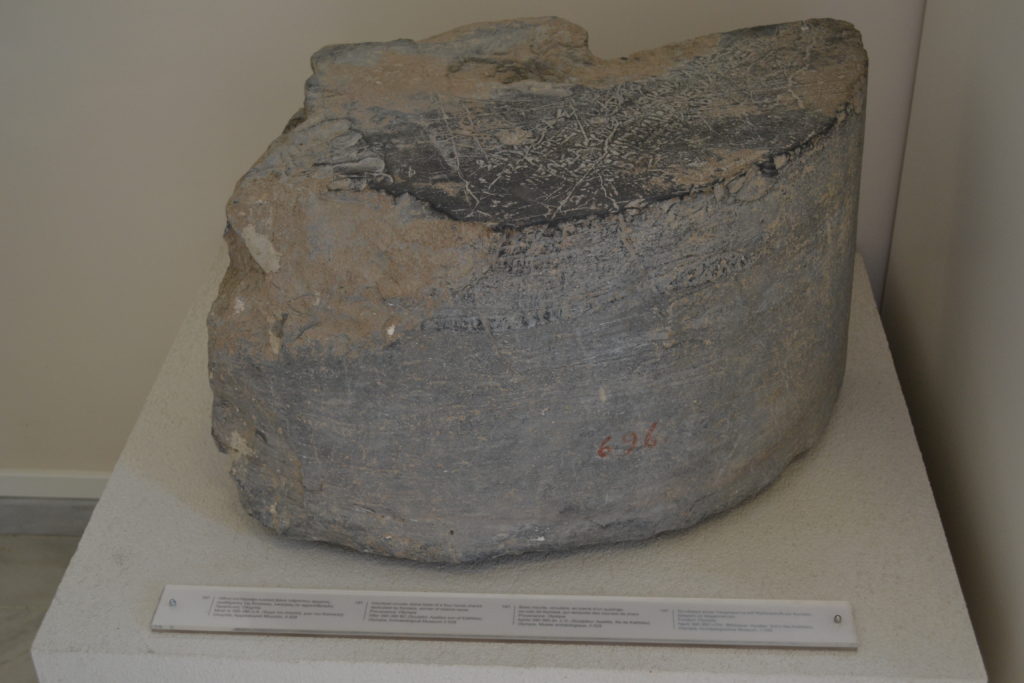
Inscribed base for the victory statue commemorating Kyniska’s victory at the Olympic Games. It is now located in a small room at the Museum of the Olympic Games in ancient Olympia, Greece. It was amazing to see this piece of stone that represented such an earth-shattering change in Olympic history!
Kyniska had thrown open the gates of Olympic competition, in one event at least, and though other women also proved victorious, her hard-won victories remained the most distinguished.
Surely the shades of Pelops and Hippodameia would have been watching intently. Certainly, her feat was amazing, for even in Sparta, a shrine was erected to her. Pausanias describes it:
At Plane-tree Grove there is also a hero-shrine of Cynisca, daughter of Archidamus king of the Spartans. She was the first woman to breed horses, and the first to win a chariot race at Olympia.
(Pausanias, Description of Greece 3.15.1)
I hope you’ve enjoyed this post about Kyniska of Sparta, the heroine of Heart of Fire. I have certainly enjoyed writing about her, and even though the sources about her a few and far between, her legacy exploded onto the pages of my story.
In the next part of The World of Heart of Fire, we will look at what exactly it meant to be an Olympic champion in Ancient Greece, and explore the immortality that was within grasp of a precious few.
Thank you for reading!
Part IX
Achieving Immortality – To be an Olympic Victor in the Ancient World
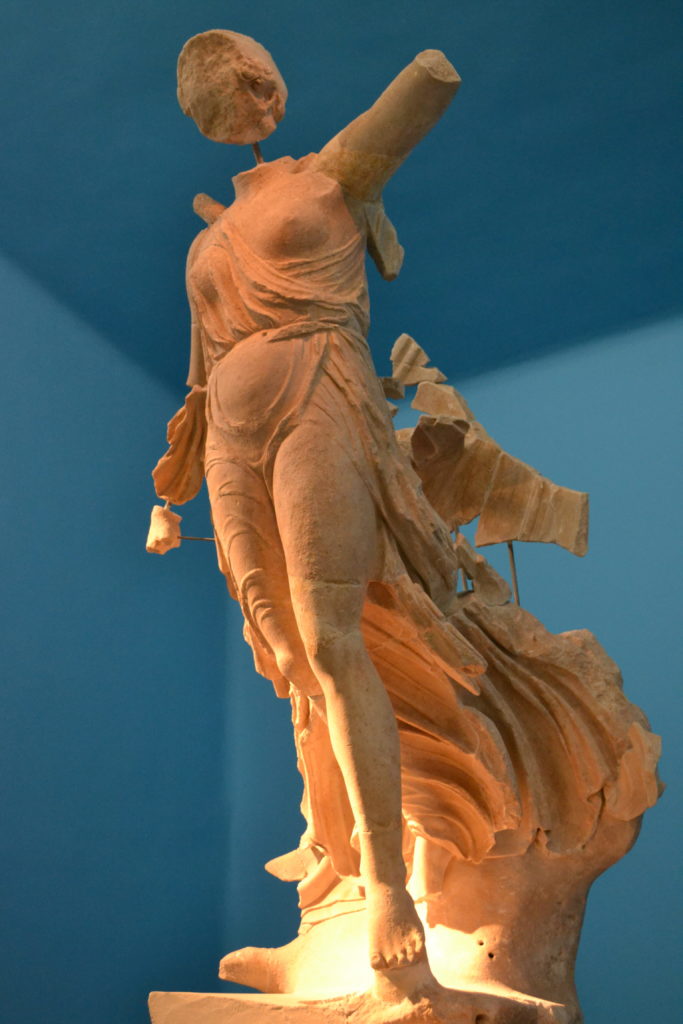
Statue of Nike, Goddess of Victory in the Archaeological Museum of Ancient Olympia
If ever a man strives
With all his soul’s endeavour, sparing himself
Neither expense nor labour to attain
True excellence, then must we give to those
Who have achieved the goal, a proud tribute
Of lordly praise, and shun
All thoughts of envious jealousy.
To a poet’s mind the gift is slight, to speak
A kind word for unnumbered toils, and build
For all to share a monument of beauty.
(Pindar; Isthmian I, antistrophe 3)
Heart of Fire is not only a story of love in war, it is also a story about sacrifice for the ultimate triumph – Victory at the Olympic Games.
In the book, and in this series on The World of Heart of Fire, we hear a lot about the ancient Greek ideals of ponos (toil), Eris Agathos (good strife), philoneikia (love of competing), and philonikia (love of winning).
They were, as we have discussed before, central to the Greek psyche, and those who epitomized those ideals were praised and respected by all other Greeks.
And the respect and admiration that was given to an Olympic champion transcended war, politics, and the boundaries of one city-state. When the Gods, by their divine grace, sought to crown an athlete and warrior who has toiled long, and hard, and honestly, then few mortals dared gainsay them, especially when it came to the sacred Olympiad.
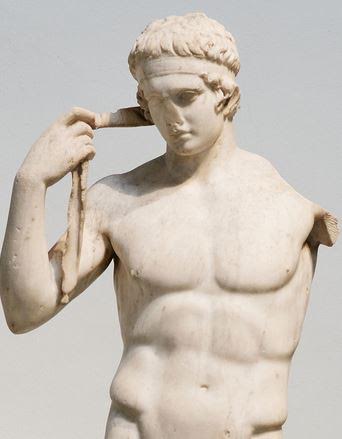
Athlete tying victory ribbon around his head
The praise of Olympic victors gave rise to a new form of art known as epinikion, which literally means ‘on victory’.
Epinikion art in ancient Greece took the form of poems, or ‘victory odes’, such as the one above, as well as marble or bronze sculpture.
First let us look at the epinikion poetry.
There were several poets who composed in the epinikion genre, but the most famous were Archilochus (680-645 B.C.), Simonides of Ceos (556-468 B.C.) who famously composed the epitaph to the 300 Spartans at Thermopylae, and of course, Pindar (522-443 B.C.).
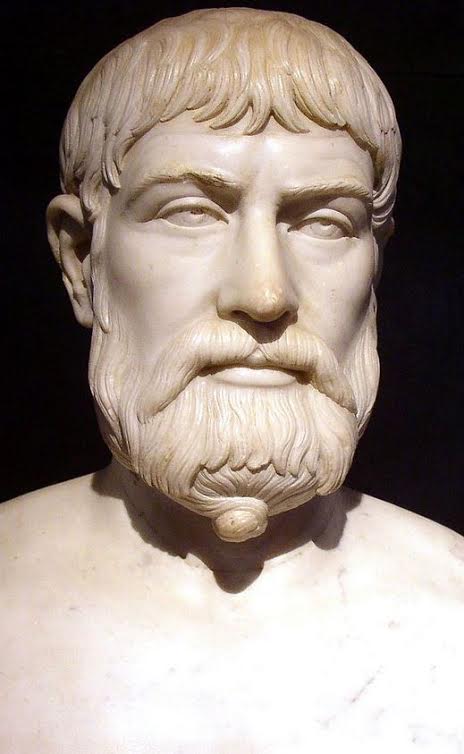
Pindar
Of all the epinikion poets of ancient Greece, Pindar is the most famous and well-known to us, partly because much of his work has been preserved. There are about thirty-eight of his victory odes which can still be read today. CLICK HERE to download a free copy of Pindar’s Extent Odes from Project Gutenberg.
There was a certain formula to epinikion poetry that began with a salute to the victor’s achievement, and then a mention of his pedigree, city, or relatives. There was emphasis on the effort and exertion, the all-important ponos demanded of athletic victory. Then the victory was incorporated into the values of the individual’s community.
Another ancient Greek ideal, that of philotimo, the love of honour, played an important role here as well. Loving honour meant bettering not only oneself, but also one’s community or city, the people around you, and the world in general.
When an Olympic victor was praised in epinikion poetry or sculpture, they were held up as an example, an inspiration if you will, to all other Greeks.
Now let Agesidamos, winner in the boxing at Olympia, so render thanks to Ilas as Patroklos of old to Achilles. If one be born with excellent gifts, then may another who sharpeneth his natural edge speed him, God helping, to an exceeding weight of glory. Without toil there have triumphed a very few. (Pindar Olympian Ode 11, for Agesidamos, winner in the boxing-match)
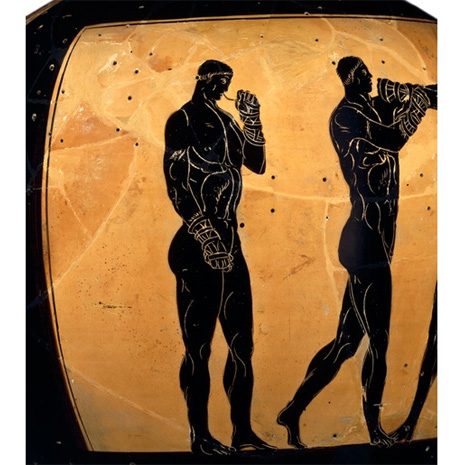
It became quite fashionable, among those who could afford it, to have a poet such as Pindar compose an ode to someone’s victory, such as the quote above. And Pindar himself travelled around doing this for a living. However, this should not detract from the power of the words of this poet.
Pindar’s words were so powerful and moving that when Alexander the Great sacked the city of Thebes for rebelling against Macedon, he ordered the home of Pindar to remain untouched, and the poet’s descendants unmolested, out of reverence for Pindar and his work.
The great epinikion poets’ work – Archilochus and Pindar especially – became so representative of the ideals of Olympic victory, that they became a part of the ceremonies at Olympia.
It is said that Archilochus’ Hymn to Herakles, one of the mythological founders of the Games, was sung during the crowning ceremonies at Olympia in the temple of Olympian Zeus. The temple, as it happened, was decorated with metopes illustrating the Twelve Labours of Herakles, the hero’s victories as it were.
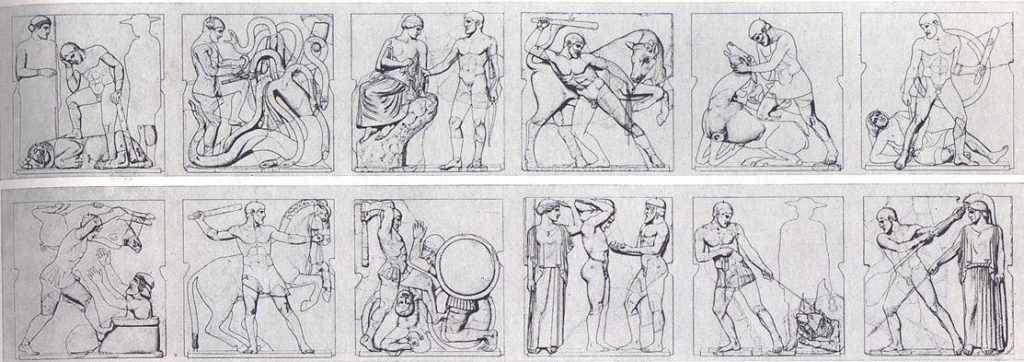
Temple of Zeus Metopes
Epinikion sculpture also played a large part in the history and atmosphere of ancient Olympia, especially in the sacred heart of the sanctuary, the Altis.
It became the tradition that at Olympia, all victors were permitted to erect statues of themselves in the Altis. In a sense, this put them almost on equal footing with the Gods themselves. Some victors, including Kyniska of Sparta, had their victory bronzes in the temple of Zeus itself!
According to Pausanias:
The first athletes to have their statues dedicated at Olympia were Praxidamas of Aegina, victorious at boxing at the fifty-ninth Festival, and Rexibius the Opuntian, a successful pancratiast at the sixty-first Festival. These statues stand near the pillar of Oenomaus, and are made of wood, Rexibius of figwood and the Aeginetan of cypress, and his statue is less decayed than the other. (Pausanias, Description of Greece, 6.18.7)
If Pausanias is correct, then the first epinikion statues, not of bronze but of wood, would have been erected in the Altis around 544 B.C.
If that date is correct, then the tradition took hold quickly enough, and victors began to commission elaborate bronzes from some of the greatest sculptors of ancient Greece, artists such as Myron of Attika, Polykleitos of Argos, Kallikles of Megara, Naukydes of Argos and others.
Victory statues were erected by successive generations of families who had many Olympic victors in their ranks, the most famous being the Diagorids of Rhodes by Kallikles.
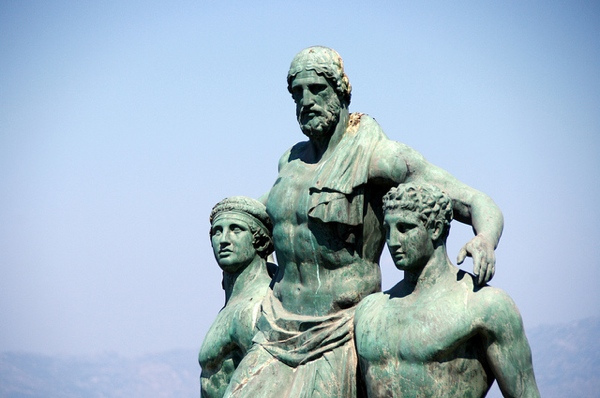
Modern bronze statue of Diagoras of Rhodes carried by his sons
The bronze statues of Diagoras who won in boxing in 464 B.C., and also at all four crown games, stood six feet six inches in height.
…I too, sending to victorious men poured nectar, the gift of the Muses, the sweet fruit of my mind, I try to win the gods’ favor for those men who were victors at Olympia and at Pytho. That man is prosperous, who is encompassed by good reports. Grace, which causes life to flourish, looks with favor now on one man, now on another, with both the sweet-singing lyre and the full-voiced notes of flutes. And now, with the music of flute and lyre alike I have come to land with Diagoras, singing the sea-child of Aphrodite and bride of Helios, Rhodes, so that I may praise this straight-fighting, tremendous man who had himself crowned beside the Alpheus and near Castalia, as a recompense for his boxing… (Pindar, Olympian Ode 7; for Diagoras of Rhodes)
The Diagorids of Rhodes were something of Olympic royalty, for not only did Diagoras claim victory, but also his sons Damagetos, Akousilaos, and Dorieus, as well as his grandson, Eukles, whose epinikion statue was also sculpted by Kallikles.
There was also the famous statue of Kyniskos of Mantinea, by Polykleitos of Argos, and another of the legendary Milo of Croton standing high on a round base and holding a pomegranate.
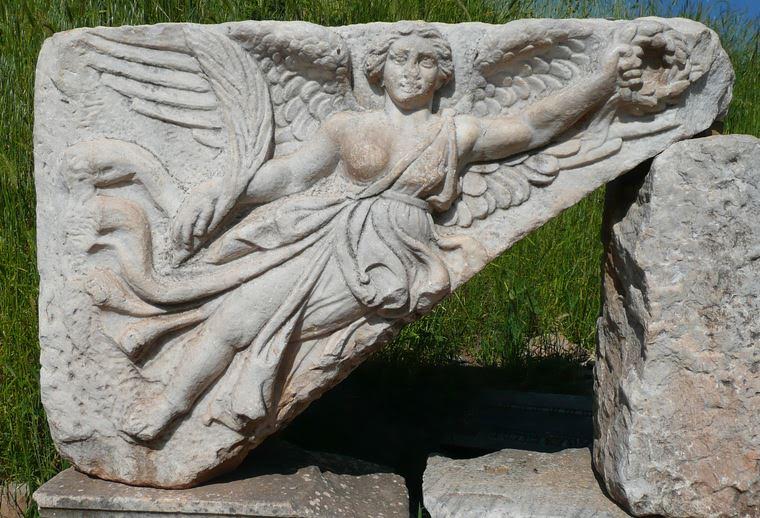
Goddess Nike, Ephesus (Wikimedia Commons)
Having one’s statues erected in the sacred Altis of ancient Olympia became something to be dreamed of by many, for in winning by the Gods’ grace, and being granted the right to erect a statues of oneself in the Altis, this was as close as one could get to immortality.
Someone who walked away from the Olympiad a victor was lauded across the Greek world, given free meals and drinks, sometimes exempt from taxation and more. The benefits of Olympic victory were indeed great, but none more so, I suspect, than knowing that the Gods had chosen you for victory.
It was a heady dream.
I tried to tap into this in Heart of Fire. The male protagonist, Stefanos of Argos, has a father who is a famous bronze smith of Argos, a centre of bronze artistry in ancient Greece. It is the dream of the father that an epinikion bronze be erected in the Altis of Olympia, and it is the son’s challenge to make that happen.
One supposes that many families of athletes had similar dreams of victory, of seeing the immortal likenesses of their fathers, sons, or grandsons erected in the forest of bronzes that stood all about the Altis, among the monuments of the gods and heroes of that place.
And every four years, when the Greek world would return to Olympia for the sacred games, the statues would remind men of those victors who had gone before, of the songs that were sung for them, and how the Gods had blessed them.
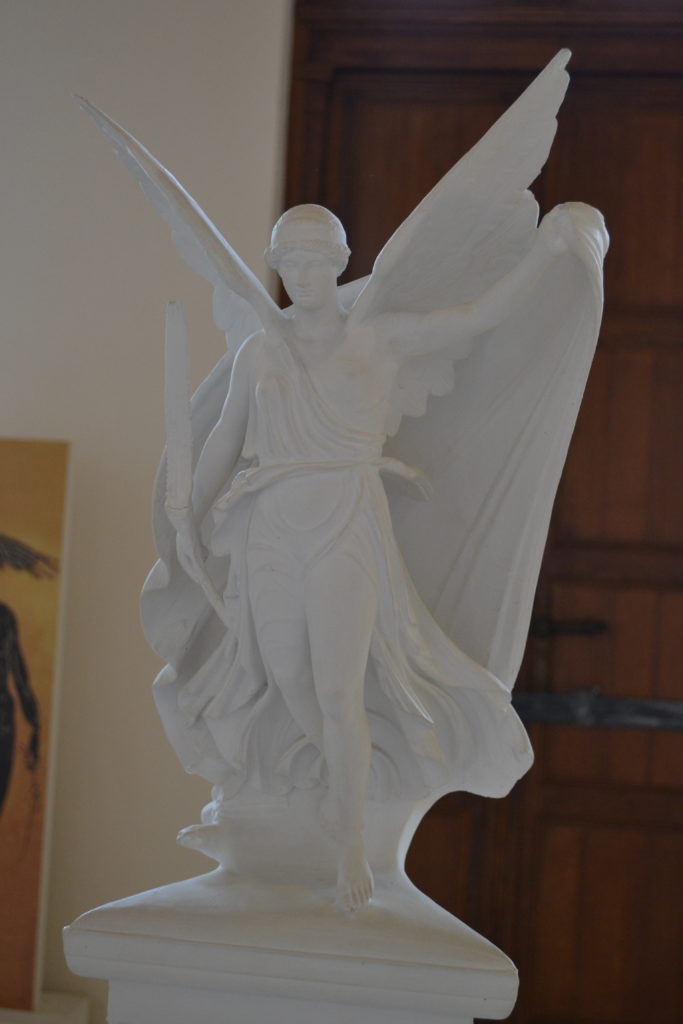
Reconstruction of the statue of Nike at the Museum of the History of the Olympic Games in ancient Olympia
Thank you for reading!
Part X
Heart of Fire: A Novel of the Ancient Olympics
This is the final post in The World of Heart of Fire blog series.
I sincerely hope you have enjoyed it.
Writing Heart of Fire has been a tremendous journey into the world of Ancient Greece. Yes, I am an historian and I already knew much of the material, but I still learned a great deal.
The intense, and in-depth, research, some of which you have read about in this ten-part blog series, made me excited to get stuck in every day. A lot of people, after an intensive struggle to write a paper or book, are fed up with their subject afterward, but that is not the case for me.
In writing this story, and meeting the historical characters of Kyniska, Xenophon, Agesilaus, and Plato, in closely studying their world, I have fallen even more in love with the ancient world. I developed an even deeper appreciation of it than I had before.
In creating the character of Stefanos of Argos, and watching him develop of his own accord as the story progressed (yes, that does happen!), I felt that I was able to understand the nuances of Ancient Greece, and to feel a deeper connection to the past that goes beyond the cerebral or academic.
I’ve come to realized that in some ways we are very different from the ancient Greeks. However, it seems to me that there are more ways in which we have a lot in common.
Sport and the ancient Olympics are the perfect example of this.
We all toil at something, every day of our lives. Few of us achieve glory in our chosen pursuits, but those who do, those who dedicate themselves to a skill, who sacrifice everything else in order to reach such heights of glory, it is they who are set apart.

In writing, and finishing, Heart of Fire, I certainly feel that I have toiled as hard as I could in this endeavour. My ponos has indeed been great.
There is another Ancient Greek idea that applies here, that comes after the great effort that effects victory. It is called Mochthos.
Mochthos is the ancient word for ‘relief from exertion’.
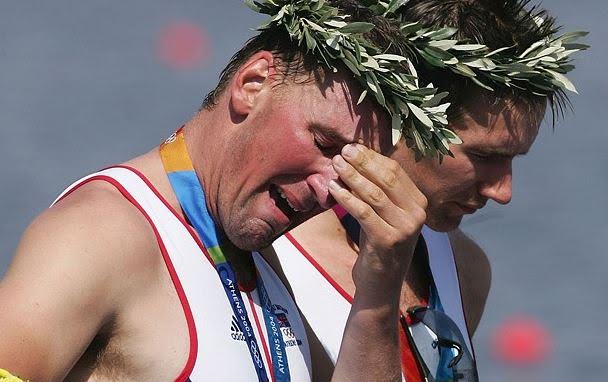
Athens 2004 – Mochthos
My moment of mochthos will come when I return soon to ancient Olympia. I have been there many times before, but this time will be different, for I will see it in a new light – the stadium, the ruins of the palaestra and gymnasium, the Altis, and the temples of Zeus and Hera… all of it.
For me, Olympia has exploded with life.
When I next walk the sacred grounds of the Altis, I’ll be thinking about the Olympians who will be competing this summer and in the years to come.
They deserve our thoughts, for to reach the heights of prowess that they do to get to the Games, they have indeed sacrificed.
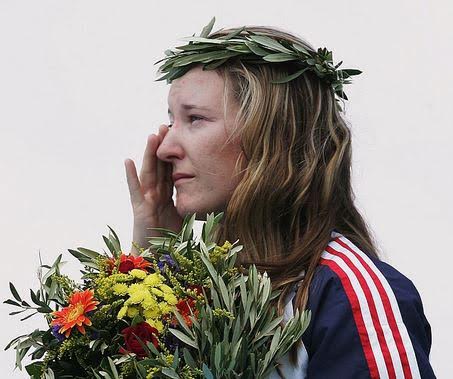
Athens 2004
I always feel a thrill when I see modern Olympians on the podium, see them experience the fruit of their toils, their many sacrifices.
It is possible that they may have been shunned by loved ones or friends for their intense dedication and focus. It can be a supremely lonely experience to pursue your dreams.
Whatever their situation, Olympic competitors deserve our respect, and just as in Ancient Greece, their country of origin should matter little to us.
Yes, we count the medals for our respective countries, but what really matters is that each man and woman at the Games has likely been to hell and back to get there.
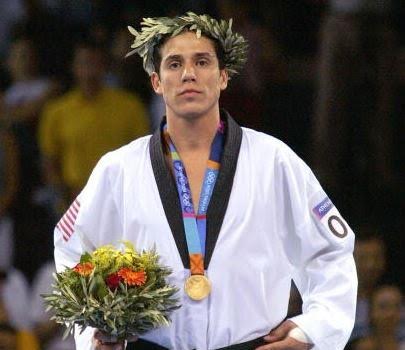
Athens 2004 proud winner
When I see the victors on the podium, when I witness the agony and the ecstasy of Olympic competition, I can honestly say that I have tears in my eyes.
Perhaps you do too? Perhaps the ancient Greeks did as well, for in each individual victor, they knew they were witnessing the Gods’ grace.
It’s been so for thousands of years, and it all started with a single footrace.
It is humbling and inspiring to think about.
Heart of Fire – A Novel of the Ancient Olympics, is out now, and I hope that I have done justice to the ancient Games and the athletes whose images graced the Altis in ages past.
A Mercenary… A Spartan Princess… And Olympic Glory…
When Stefanos, an Argive mercenary, returns home from the wars raging across the Greek world, his life’s path is changed by his dying father’s last wish – that he win in the Olympic Games.
As Stefanos sets out on a road to redemption to atone for the life of violence he has led, his life is turned upside down by Kyniska, a Spartan princess destined to make Olympic history.
In a world of prejudice and hate, can the two lovers from enemy city-states gain the Gods’ favour and claim Olympic immortality? Or are they destined for humiliation and defeat?
Remember… There can be no victory without sacrifice.
Be sure to keep an eye out for some short videos I will be shooting at ancient Olympia in the places where Heart of Fire takes place. I’m excited to share this wonderful story with you!
Thank you for reading, and whatever your own noble toils, may the Gods smile on you!
To watch the full video series touring the archaeological site of Ancient Olympia, CLICK HERE!


